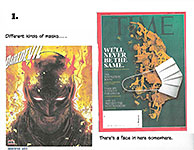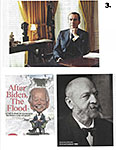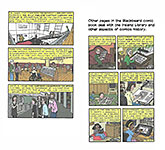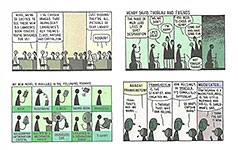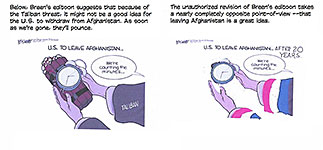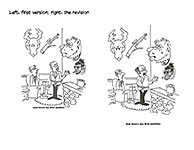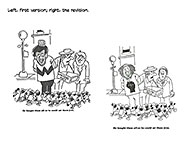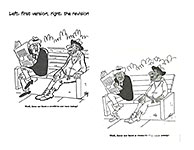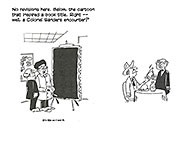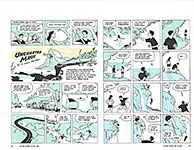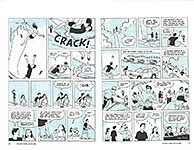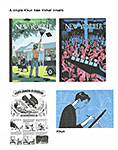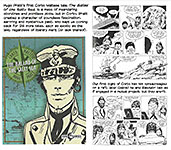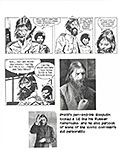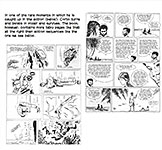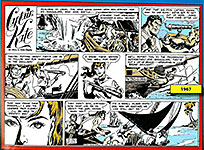 |
||||||||||||||
Opus 420 (through August 5, 2021). We’ve packed a lot into this posting in order to showcase Rancid Raves for visitors during Open Access Month when even non-$ubscribers can wander the environs. (And after you have, we hope you’ll $ubscribe.) This could be dubbed our Editoon Issue: we examine a selection of July’s political cartoons— over 80 of them (anti-vaxxers, the Big Lie, and other ponderous issues). But it ain’t all politics. We review the first Corto Maltese book; and we also review the Bill Blackbeard comicbook, Snooty Bookshop (50 literary postcards), the Will Eisner DVD, and several comicbooks, and we ponder The Case of Bill Cosby and a 4-page comic strip in The New Yorker, otherwise (?) the last bastion of the single-panel (?) gag cartoon. And more. Here’s what’s here, by department, in order (the longest entries are marked with an asterisk* — a reader’s guide to help you decide where to spend your time)—:
NOUS R US Zyglis Editoons Are Disappeared—Or Not? Introducing Mister Oswald Walt Disney World Turns 50
FUNNYBOOK FAN FARE Reviews of —: Time Before Time, No.1 Resident Alien, Sixth Chaykin’s Hey Kids! Comics No.2
ELECTION RETURNS *Trumpist Anti-Vaxxers Dying Off, Destroying His Base
TRUMPERIES EDITOONERY A Selection of the Past Month’s Editorial Cartoons *The Case of Bill Cosby
THE FROTH ESTATE News Media Failing In Its Duty
NEWSPAPER COMICS PAGE VIGIL The Bump and Grind of Daily Stripping Oddities and Amazings Amongst the Strips
ACCRETION OF INTENTION DEPARTMENT Will Eisner: Portrait of a Sequential Artist DVD Did Eisner Invent the Term and Form “Graphic Novel”?
RANCID RAVES GALLERY Cover Art
BOOK MARQUEE Short Reviews and Proclamations of Coming Attractions *Bill Blackbeard: The Collector Who Rescued the Comics Comicbook The Snooty Bookshop: Fifty Literary Postcards Jake Tapper Recommends 6 Books about the Rat Pack Era
BOTTOM LINERS Single Panel Magazine Cartooning Cartoons by Novelist Charles Johnson
*Comic Strip in The New Yorker Kikuo Johnson Bio
LONG FORM PAGINATED CARTOON STRIPS Called Graphic Novels for the Sake of Status **The Ballad of the Salty Sea: A Corto Maltese Graphic Novel
COLLECTORS’ CORNICHE Captain Kate Comic Strip
PASSIN’ THROUGH Kathleen Andrews of Andrews McMeel Universal John McMeel Richard Donner
QUOTE OF THE MONTH If Not of A Lifetime “Goddamn it, you’ve got to be kind.”—Kurt Vonnegut Our Motto: It takes all kinds. Live and let live. Wear glasses if you need ’em.
But it’s hard to live by this axiom in the Age of Tea Baggers, so we’ve added another motto: Seven days without comics makes one weak. (You can’t have too many mottos.)
And in the same spirit, here’s—: Chatter matters, so let’s keep talking about comics. AND— “If we can imagine a better world, then we can make a better world.”
And our customary reminder: don’t forget to activate the “Bathroom Button” by clicking on the “print friendly version” so you can print off a copy of just this installment for reading later, at your leisure while enthroned. Without further adieu, then, here we go—:
NOUS R US Some of All the News That Gives Us Fits
ZYGLIS EDITOONS ARE DISAPPEARED—OR NOT? The Buffalo Newspaper Guild is going on an indefinite byline strike: members are withholding their names from their stories and photos, in protest of changes proposed by the Buffalo News’ new ownership, Lee Enterprises, and management. And Adam Zyglis, the paper’s editoonist, has joined in the boycott. Zyglis explains: “Why are you not seeing my cartoons? All of us in the Buffalo Newspaper Guild are participating in a byline strike to protest the harmful proposals from Lee Enterprises in our contract negotiations. My editors have chosen not to publish my unsigned cartoons for the duration of the boycott.” So, says D.D. Degg at the DailyCartoonist, “if Adam won’t sign his cartoons, the News won’t run them. But if other journalists won’t sign their content, the News will run them?” If the News treats reportage the way Zygliz’s cartoons are being treated, the paper will be completely empty of local news. Apparently Lee Enterprises, which bought the News in 2020, is proceeding along the lines it and other corporate owners have followed in buying up newspapers: to increase profits, they’re reducing expenses—which usually means, they’re firing staff (or are about to). Here’s the Buffalo Newspaper Guild’s explanation: “Lee Enterprises, the out-of-state owner of The Buffalo News, is waging an assault on the 150 union workers who help produce the award-winning paper — the people who write stories, take photographs, edit and design pages, provide customer service to our readers and get the paper delivered. “Lee Enterprises wants concessions that threaten the quality of a newspaper with the largest newsroom in Upstate New York and the primary source of news for more than 100,000 readers in the Buffalo-Niagara region. “Lee Enterprises wants to ship our jobs to Mexico and the Midwest, eliminating one-fourth of the jobs performed by members of the Buffalo Newspaper Guild, the largest union at the News. The company wants the power to lay off anyone at any time for any reason and freeze union members’ pensions even though the pension is fully funded and doesn’t cost the company a dime.” The Guild is scarcely keeping quiet about the dispute. It’s putting up a fight against the owners with a billboard in downtown Buffalo, calling out Lee Enterprises. In big letters, it says: “The Buffalo News’ out-of-town owner is bad news for readers and workers.”
INTRODUCING MISTER OSWALD (In Case You’ve Forgotten) Rob Stolzer, a collector of original comics art and a dedicated afficionado of the medium, just announced the “opening” of his new website devoted to Russ Johnson and his comic strip, Mister Oswald. Mister Oswald was a monthly comic strip that ran in a Sunday-size full-page format in Hardware Retailing magazine, starting in October 1927. Mister Oswald owned and operated a hardware store, and the strip thus became, as Stolzer puts it, “a time-capsule of sorts, portraying the trials and tribulations of a hardware store owner during the Great Depression, wars, and changing technologies.” Johnson
brought to the strip the authority of his own life experiences: in Gibson City,
Illinois, he owned a hardware store and a shoe store so he knew whereof he
spoke. And he spoke through Mister Oswald for 62 years. After Johnson retired
from the strip, it was continued for another 20 years by his assistant, Larry
Day. Says Stolzer: “Russ’ work featured excellent character development, strong line work, and a wonderfully delineated sense of place. I’ve often wondered how many nuts and bolts Russ drew during his 62 years drawing Mister Oswald. It had to have been in the tens of thousands.” In the early 1920s, after serving in WWI, Johnson studied with Carl Ed and Billy DeBeck in Chicago. “ They taught him well,” says Stolzer. “I've owned the domain name for a number of years,” Stolzer went on, “and have just recently been given permission from the fine folks at Hardware Retailing to move forward with the website. “If anyone has material by Russ they would like to share, I would be glad to consider adding it to the site,” Stolzer added. “And if anyone would like to make a guest-blog appearance, please do let me know.” You can subscribe to the site to be notified of each new posting of Mister Oswald at https://misteroswald.com/ / And there, Stolzer has provided a biography of Johnson and numerous other informative matters. I’ve been a fan of Mister Oswald ever since Don and Maggie Thompson in one of their Beautiful Balloons columns in The Comics Buyer’s Guide, announced in about 1968 the publication of a 286-page book collection of the strip, Forty Years with Mister Oswald. (My copy is autographed, but I can’t tell you how that came about. I lived near Gibson City at the time, but I never met Johnson. I think a friend got the book for me and had it autographed.) I enthusiastically endorse Stolzer’s enterprise. Stolzer adds: “There is a subscription button at the bottom of each page, for anyone who would like to receive site updates.”
WALT DISNEY WORLD TURNS 50 Disney World will hit it’s 50th anniversary this fall. October will kick off an 18-month celebration. The castle is being made over and all sorts of events are planned, reports David Cohea in ReMind (August). On October 1, 1971, the Magic Kingdom, Contemporary Resort Hotel, and Polynesian Village were officially opened. “Fort Wilderness opened a month later,” Cohea said. Admission was $3.50 for adults, $2.50 for juniors under age 18, and $1 for children under 12. Said Cohea: “The resort now includes two water parks, 27 themed hotels, nine non-Disney hotels, several golf courses, a camping resort, entertainment venues, and the outdoor shopping center Disney Springs.”
ODDS & ADDENDA Two fresh Eisner winners: Invisible Men: the Trailblazing Black Artists of Comic Books by Ken Quattro; and Trina Robbins’ The Flapper Queens: Women Cartoonists of the Jazz Age. Said Trina: “Thank you, Gary Groth, my editor Kristy Valenti, and my wonderful designer, Chelsea Wirtz, and thanks to everybody who voted for me. I'm happy as a clam in high tide!”
Fascinating Footnit. Much of the news retailed in the foregoing segment is culled from articles indexed at https://www.facebook.com/comicsresearchbibliography/, and eventually compiled into the Comics Research Bibliography, by Michael Rhode, who covers comic books, comic strips, animation, caricature, cartoons, bandes dessinees and related topics. It also provides links to numerous other sites that delve deeply into cartooning topics. For even more comics news, consult these three other sites: Mark Evanier’s povonline.com, Alan Gardner’s DailyCartoonist.com (now operated without Gardner by AndrewsMcMeel, D.D. Degg, editor); and Michael Cavna at voices.washingtonpost.com./comic-riffs . For delving into the history of our beloved medium, you can’t go wrong by visiting Allan Holtz’s strippersguide.blogspot.com, where Allan regularly posts rare findings from his forays into the vast reaches of newspaper microfilm files hither and yon.
FURTHER ADO It is a fearful thing to love what death can touch.—Dunno Grief is the price we pay for love.—Queen Elizabeth II
FUNNYBOOK FAN FARE Four-color Frolics An admirable first issue must, above all else, contain such matter as will compel a reader to buy the second issue. At the same time, while provoking curiosity through mysteriousness, a good first issue must avoid being so mysterious as to be cryptic or incomprehensible. And, thirdly, it should introduce the title’s principals, preferably in a way that makes us care about them. Fourth, a first issue should include a complete “episode”—that is, something should happen, a crisis of some kind, which is resolved by the end of the issue, without, at the same time, detracting from the cliffhanger aspect of the effort that will compel us to buy the next issue. A completed episode displays decisive action or attitude, telling us that the book’s creators can manage their medium.
A BOOK WITH A TITLE like Time Before Time, we’d expect to be about time. And so it is. Time travel to be exact. The protagonist is Tatsuo Edwards, who works for the Syndicate, a cruel 22nd Century crime gang that illegally smuggles people back and forth in time to what they believe are “better” eras. In No.1, writers Declan Shalvey and Rory McConville introduce Tatsuo to Oscar, and the two plan to escape the Syndicate by stealing one of the time-traveling pods and taking off for parts unknown—or, at least, places where they can evade forever the clutches of the Syndicate. Unfortunately, Oscar is taken on a time-traveling “ride” and gets himself bunged up so bad that he commits suicide. Tatsuo decides to try on his own, and just as he’s about to take possession of a pod, he’s “caught” by a female FBI agent, who forces him to take her to June 19, 2042. Just as they board the craft, they are attacked by a bunch of thugs. The pod is vaguely damaged, and things go black. Next thing Tatsuo knows, he and the FBI gal, Nadia Wells, wake up in a desert. Some place. Or, to use Tatsuo’s expression, “some when.”
In No.2, Tatsuo and Nadia fall into the hands of another crime gang, the Union, which has been conducting a turf war with the Syndicate for years. Just as they’re about to be shot dead, Tatsuo makes a deal that saves their lives: he’ll tell the Union chief things about the Syndicate that will help the Union win the war. Intriguing as the book’s time-traveling notion is, it’s the artwork that stuns. Joe Palmer draws with a bold line and simple outlines, but he jazzes it up with lots of solid blacks, silhouettes as well as shadows. This is fun stuff.
THE SIXTH Resident Alien miniseries, “Your Ride’s Here,” ended with No.6, in which it appeared, as this series drew to a close, that the Alien, who began comicbook life stranded on Earth, was going to be able to take a spaceship back to his home planet. Created by writer Peter Hogan and artist Steve Parkhouse, the Alien books are among the medium’s top quality series. Apart from being good storytelling well-drawn, the series has heart and humanity. The series includes Welcome to Earth (2012-2013), The Suicide Blonde (2014), The Sam Hain Mystery (2015), The Man With No Name (2016-2017), An Alien in New York (2018), and Your Ride's Here (2020-2021). The Alien’s previous adventures have been collected in three books (the first three in one volume; the others, in individual titles). And Hogan and Parkhouse aren’t finished yet. Starting in January 2021, the Alien is also on television— Syfy. It is, St. Wikipedia asserts, more humorous than it is in the graphic novel form because of actor Alan Tudy’s comedy skills.
HOWARD CHAYKIN IS BACK AGAIN with the second issue of the second “volume” of Hey Kids! Comics! And it’s more of the same that we saw in the first issue. Talking heads mostly in repetitive albeit inventive when first observed page layouts. The “cast” is pictured by individual mug shots on the inside front and back covers: 23 of them this time (last time, it was only 21), and only one is female. But the title is about the comicbook industry in the 1950s, and women didn’t figure much in the business at the time. Chaykin has returned to a trait he indulged in the first “volume”—spewing racial and ethnic slurs right and left. I suppose he thinks this makes his story more realistic. Alas, it only makes it distasteful. Not much progress is made in this issue towards determining a plot, which is too bad: by the second issue, any comicbook title ought to have a discernible plot. Although there is a dead body somewhere. Otherwise, the book is all bickering among its voluminous cast members, most of whom cannot be easily identified despite the inside front and back cover guide. In short, based upon the second issue, this “volume” of Hey Kids! looks pretty much like its predecessor—a confused excuse for Chaykin to avenge himself on 1950s comicbook industry personnel whose lack of respect for the medium angered him with a chorus of racial slurs.
QUOTES & MOTS Strange But True Early Hoover vacuum cleaners were hard to sell because potential customers refused to believe they could have that much dirt in their carpets. The shape of the Coca-Cola bottle is patterned after a cacao seed pod. “Hurkle-durkle” is an old Scottish word meaning to lie in bed after it’s time to get up and get going.
ELECTION RETURNS The data is now emerging. States that voted for the Trumpet in the last election are, obviously, awash in Trump cultists. And by significant percentages, the people in these states are not getting vaccinated. They are often vociferous anti-vaxxers. And anti-vaxxers are being admitted to hospitals because they’re suffering from Covid-19. The people who are dying from the plague in these states are determined anti-vaxxers. Or, at least, they haven’t been vaccinated for whatever reason. Many, no doubt, are acting on what they assume is the belief of their Beloved Leader, the Trumpet, who, while saying he believes in the efficacy of vaccines, also said repeatedly over the years that he believes vaccines cause autism. Whatever they believe, people in the Trump States are not getting vaccinated, and people who haven’t been vaccinated are the ones now dying in those states. You’d think Trump would react strategically to this information. After all, Covid-19 is killing off his supporters. At this rate, there won’t be enough Trump cultists left to win anyone’s election in 2022 or 2024. If the Trumpet were paying attention to the actual world, he’d get on the horn and encourage his followers to get vaccinated so they’ll be alive to vote for him next time. But he hasn’t said anything. That’s because he’d rather be “right” in his own view than “right” in the eyes of science. So the Democrantz can relax. What’s left of the pandemic will soon kill off enough Trumpists to eliminate any chance that a Trump cultist (or a dedicated, conservative Republicon—or the Trumpet himself) could be elected. All the elections will be won by Democrantz because there won’t be enough Trumpists to win any election anywhere.
THE OTHER CONSEQUENCE of the Trumpet’s silence is that he must bear the blame for the deaths of thousands more Americans. The ones who are dying are the anti-vaxxers. And the anti-vaxxers tend to be Trumpists, so if the Trumpet were to go on national television and explain why he and the rest of his family have chosen to get vaccinated, presumably a lot of the anti-vaxxers would cease being anti-vaxxers and get vaccinated, thereby saving their lives. But the Trumpet will not do this. He should care about anyone else’s life?
The Antics and Idiocies of Our Bloviating Buffoon in Chief YES, HE’S STILL AROUND. Not as often (i.e., not 4-5 times a day with a new outrage every time as was the prevailing mode during his presidency) but still, somewhat. So we’re maintaining this special department in which editoonists ridicule the man who deserves it most. Editoonist Nate Beeler, in a recent posting to Counterpoint (about which, more anon), said: “It’s tragic that so many in the GOP are still in former President Trump’s thrall. ... There may be enough people of good conscience in the Republican Party but you’d never know it right now. Among the prominent members of the Right, there’s been an almost complete capitulation to Trump’s influence. Instead of leading the party toward an inspiring, positive, and conservative future, they are embracing the most divisive, pathetic, RINO, one-term U.S. President in history.” With
that as introduction, we turn to our visual aid, at the upper left of which Pat
Bagley shows the Trumpet having an infantile fit because he’s been deprived
of his Facebook platform—depicted here as a smoking gun that smokes “Lies,”
which is what the Trumpet specializes in spreading. Next around the clock, Christopher Weyant depicts the Trumpet as a bawling baby in diapers, sitting amid the burned-to-the-ground U.S. capital and complaining that he’s been deprived of the matches he used to cause the totally destructive fire. Bagley is back in the lower right with an image that explains the obstacles in the way of any investigation of January 6, the day of the insurrection. The investigative magnifying glass is being impeded, attacked and cracked by Kevin McCarthy who’s poking at it with a “Trump 2024" presidential campaign flag, led by Mitch McConnell with a stick in his hand. Therefore, the Republicon attitude towards an investigation is controlled by their hopes for a victory for Trump in 2024: an investigation might make him more culpable and therefore not a good candidate for the presidency. Finally, John Deering closes out our visit with the appalling Trumpet this time. His imagery shows various prominent Republicons, starting with Ted Cruz at the lower left, lining up to worship the Trumpet flag. Counterpoint, by the way (although not at all incidentally) is an online political cartoon service that provides to its $ubscribers at least 10 cartoons a week at the rate of two a day—one liberal, one conservative—for a measly $7/month. And now, onward to the rest of political America.
EDITOONERY The Mock in Democracy THIS DEPARTMENT is swollen enough this time that you aren’t likely to read it all at first sitting. But for those hardy souls who try, we’ve juggled a few things to break up the monotony. We’ve installed “breaks” of single-panel magazine cartoons in a hopeful attempt to still the lecturing voice of yrs trly. And we’ve insinuated in the midst of the pictures a long essay on Bill Cosby. The
purpose of this department is to draw your attention to the way editoonists
deploy images to convey their messages. Once aware of how the images are
manipulated, your enjoyment of the genre will presumably be enhanced. Take, for
example, the imagery provided by Pedro Molina at the upper left of our
first exhibit, which is devoted to examining the vaccine war presently being
waged between (a) those who have taken the shots and believe them to protect
them from the coronavirus and (b) those who actively oppose taking the
shots—for a variety of absurd reasons. (Some believe the vaccine causes
infertility; others say the shots cause autism.) The star of Molina’s cartoon is the fat guy in the center, who, by wearing a red cap, is probably proclaimed a MAGA Trumpster (even though the lettering reads “Anti Vax”). He is aboard a subway car, and the cartoon’s commanding image is of him lighting the fuse on a bomb that looks like the symbol for Covid-19. He announces that in lighting the fuse he’s “taking his chances.” But the bomb’s explosion will harm more than the MAGA Man: the subway car is crowded, and many of his fellow passengers behind him are likely to be killed by the explosion. Molina’s bomb and its threat of exploding is a powerful image, and by deploying it to depict some of the dilemma the vaccine war presents, Molina makes the threat seem more powerful. Molina writes: “Anti-vaxxers say they are willing to take the risk of not getting vaccinated. ... [But] when they refuse to take all measures to contain the spread of contagion, they prolong the pandemic unnecessarily and put society and the economy at risk”—not to mention all the rest of us. Next around the clock we have John Darkow’s image of Uncle Sam pushing the Covid-19 Delta variation boulder symbol up a mountain, Sisyphus-like, unaware that his progress is being hindered by an Anti-vaxxer who is pushing the other way. The imagery condemns the Anti-vaxxer and his obstructive attitudes. Uncle Sam is puzzled by how hard it is to shove the boulder up the mountain: “You’d think,” he says, “that with the success of the first anti-virus vaccine, fighting the Delta variation would be easier.” Yeh, but then we’ve got the anti-vaxxers, who weren’t much heard of until Delta. Christopher Weyant’s imagery at the lower right suggests what is likely to happen to the vociferous anti-vaxxer, who is depicted falling from an airplane without a parachute (namely, as the backpack on the other plummeting personage reveals, the Covid vaccine). Next, Mike Luckovich takes two panels to condemn Fox News for leading the public astray—telling viewers that the vaccine is not likely to protect them from getting the disease. Gullible Fox News viewers, Luckovich strenuously suggests, will do whatever Fox News tells them to do—like jump off a cliff.
THE VACCINE AND
THE ANTI-VAXXERS made most of the news over the past 30 days, and editoonists
did their best to show how silly much of the anti-vaxx position was/is. In our
next display, Marshall Ramsey gets things going with a slightly revised wolf-vs-pigs
tableau. By labeling the pigs Vaccinated and Unvaccinated and the wolf Delta
Variant, the effectivenss of Ramsey’s imagery depends upon our knowing the
fairy tale of the three little pigs, two of whom built their houses out of
straw or twigs, which a marauding wolf could easily blow down. But the third
little pig, building his house of brick (i.e., getting vaccinated), made
himself safe from the wolf. Mike Peters in the next editoon reduces the warfare to its most elemental components—Trumpsters (in red MAGA caps) vs. the masked (and probably vaccinated) multitudes. Then Matt Davies shows the fallacy of the policy of letting the vaccinated avoid mask-wearing in places of business. Forced to rely upon the testimony of individuals about their vaccinated status, we could well finish by accepting the word of anti-Fauci anti-vaccine Covid-big-hoax crazies. Then Drew Sheneman lumps all the craziness together in an insane explanation. The Trumpster depicted here doesn’t recognize the contradiction in his stated positions. Why should he? By following the Trumpet, he’s already accepted the biggest contradiction in American politics today— that in his Presidential ambitions, the Trumpet means to do good for Americans. Nope: just for himself. This guy is more jerk than genius, kimo sabe. By a long shot. Voting
and the growing mound of restrictions about it make up the next big issue of
the month. In our next array, with the first cartoon at hand on that topic, Kevin
“Kal” Kalaugher makes a mockery of the Right to Vote. His image is a giant
maze, with a voting box in the middle. The aerial view shows that the maze will
never permit anyone to reach the voting place. And the GOPachyderm surrounds
the maze, holding signs pointing “right” that, if followed—as everyone here is
doing— will only lead you in an endless circle. The Pachyderm says he believes in the right to vote but some Americans have more rights (more pointless pointing signs) than others (and they’ll never get to vote). Matt Wuerker’s two-panel analysis of “recent changes to our electoral system” reveals its essential albeit contradictory flaws. In the first panel, African Americans, although dutifully following the Voter Handbook, encounter one last hurdle: they must produce an ID to prove their identity. But the big-money corporate backers can buy an election’s result and we don’t get to know who they are because their identities are protected by recent legislation. Chris Britt’s image shows a world in the midst of a monstrous flood caused by a warming planet in which the GOPachyderm’s response is to misdirect our attention to such comparatively trivial matters as vote restriction, the January 6 insurrection, and the Trumpet—ignoring the more proximate dangers that should be addressed. Then Phil Hands turns the whole voter restriction debate on its head by deciding that the absence of evidence of voter fraud shows that there’s a “massive cover-up” going on. Those who believe either are clearly deluded. And they believe it because they’ll believe whatever the Trumpet tells them to believe—including “the Big Lie,” that the election was stolen from him. In
our next visual aid, Bill Day’s imagery shows a Republicon elephant
whose nose, like that of the legendary Pinocchio, is growing with every lie the
pachyderm utters—grows and grows until it is a veritable tree, the leaves of
which reveal the sources of the lies; the trunk, the spreaders of the lies. Liz Cheney’s dubious relationship with the Grandstanding Obstructionist Pachyderm made a few headlines last month. John Darkow at the upper right plays upon House minority leader Kevin McCarthy’s last name to suggest that he is a reincarnation of another generation’s McCarthy, the Joseph R. version that gave us McCarthyism, which destroyed reputations and careers by insinuation and smear. Then Bill Bramhall creates a telling image in which the GOPachyderms are marching under the Trumpet flag but goose-stepping in the fashion of Hitler’s fascist troops of yore. Liz would scarcely want to join this bunch. And Mike Luckovich offers imagery that gives us a new term of opprobrium in these days of the Big Lie—“small noser.” The
scandal of the month continued to be the January 6 scandal, which Republicons
are now diligently white-washing: that screaming mob of looking for Nancy
Pelosi to hang her—just a bunch of tourists. And, as Drew Sheneman’s image
suggests, they were just looking for the Capital gift shop. And then we come to Bill Cosby, who has been released from jail, having served almost three years of his three-to-ten year sentence for drugging women and then sexually attacking them. Michael de Adder’s offering reconstructs a typical Cosby seduction scene with him pouring another glass of wine that will render his victim unconscious. The woman in question here is Lady Justice, and in de Adder’s view, she (it) is what has been raped. Then Steve Sack gives us two panels comparing Cosby’s future and his victims’ future: Cosby is leaving prison, but his victims are just entering theirs, a private hell of recollection. I have a somewhat different view of the Cosby situation, and we’ll now take a long detour during which I explain. We’ll return to the month’s editoons with a paragraph in red down the scroll (in case you’d like to skip the screed, head for the red). And now—: THE CASE OF BILL COSBY And All the Guilty People In 1965, Cosby, known then only as a standup comedian, was cast alongside Robert Culp in the “I Spy” espionage adventure series on NBC, and “I Spy” became the first weekly dramatic television series to feature an African-American in a starring role. It was one of the ratings hits of the season, finishing among the twenty most-watched shows that year. Cosby made history when he won the Primetime Emmy Award for Outstanding Lead Actor in a Drama Series in 1966, making him the first African American to earn an Emmy Award for acting. He won the Emmy two more consecutive times. “I Spy” ended after its third season, in April 1968. Perhaps Cosby’s most successful tv experience was the sitcom “The Cosby Show,” which aired from 1984 to 1992 and was rated as the number one show in America from 1985 through 1989. The sitcom highlighted the experiences and growth of an affluent African-American family. During this time, Cosby gained a reputation as "America's Dad" for his portrayal of Cliff Huxtable, the father in the tv family. Cosby has received various awards for his work as a standup comedian and actor in both television, and film including five Primetime Emmy Awards, eight Grammy Awards, two Daytime Emmy Awards, and two Golden Globe Awards. He also received the Presidential Medal of Freedom in 2002, and the Bob Hope Humanitarian Award in 2003. And he received a Star on the Hollywood Walk of Fame in 1977. But these achievements have been rendered null and void and assigned to the everlasting limbo of history denied because Cosby was accused by some 60 women of drugging them and then assaulting them sexually. A jury found him guilty in 2018. Due to these sexual assault allegations and Cosby’s subsequently being found guilty, numerous awards and honors have been rescinded including the Kennedy Center Honor which he received in 1998 and was rescinded in 2018 as well as the Mark Twain Prize for American Humor which he received in 2009 and was rescinded in 2018. On May 3, 2018, Cosby was expelled as a member of the Actors Branch of the Academy of Motion Picture Arts and Sciences along with Roman Polanski and Harvey Weinstein. We are nothing if not fickle in our admirations.
AT THE END OF HIS TRIAL THREE YEARS AGO, Cosby was sentenced to prison for three-to-ten years. Then, all of a sudden—just last month— a judge ordered Cosby released. It seems Cosby was a victim of a court system playing fast and loose with its moral integrity. He had given testimony in another trial on the condition that his testimony—which involved his admission of guilt in the drugging and rape accusations—not be used against him. But then, a few years later—and after a change in attorneys general—his testimony was used against him, resulting in his imprisonment. Foul play, said the judge, and ordered Cosby’s release. So now Cosby is a free man. The judge also said he could never be prosecuted again on the original charges. At his release, he had served almost three years, the minimum required in a three-to-ten sentence. Let me be clear about at least one thing. Cosby’s behavior—his seducing women to his hotel room whereupon he forced sex upon them—is despicable and cannot, under any circumstances, be excused. But there are elements in the situation that seem to me to reduce the severity of his bad behavior. The first of these concerns the women. Some of them were aspiring actresses, and when Cosby invited them to his room to give them advice on their careers, they believed him. Given the casting couch legends that cluster around Hollywood and the movie business, it is astonishing to me to realize that there are aspiring actresses in Hollywood who would actually fall for Cosby’s pitch. In short, the women are at least partially to blame for the fate that befell them. Some of the women were not aspiring actresses, but they cannot be so naive as to believe whatever Cosby told them in order to get them to visit him in his room. Surely they knew—or strongly suspected—that Cosby wanted to get in their pants. So much for the women. But their wobbly circumstances scarcely let Cosby off the hook. Newspaper accounts of Cosby’s serial seductions always say he “drugged them and raped them.” The drug in question is seldom specified, but when it is, it’s identified as quaaludes. For many years, quaaludes were used by any number of men and women to enhance their pleasure in sexual intercourse. Quaaludes at first were not illegal. They were a legal, recreational drug. So to say Cosby drugged his victims before raping them makes him appear a good deal more sinister and evil than he actually was. He was simply participating in a cultural sexual maneuver that many people at the time were also enjoying. At least some of his victims neglected to mention, no doubt, that Cosby introduced quaaludes into their foreplay by saying they would make the sex better. In other words, he probably didn’t drug them without saying what he was doing. Unfortunately, one of the occasional side effects of using quaaludes is that the user sometimes falls asleep. No doubt some of Cosby’s partners were asleep when he had sex with them, a circumstance that gives credence to the accusation that he drugged them and raped them (while they were unconscious). But Cosby very probably did not intend to make the women fall asleep. In Cosby’s mind, the sex he enjoyed with these women was consensual. Hence, his steadfast insistence that he was innocent of the charges brought against him. He has never retreated from that insistence. And because of his belief about the circumstances and himself, he would not, while in prison, agree to participate in treatment for sexually violent predators. In his mind, having consensual sex with women does not make him a sexually violent predator. And because he refused to participate in this kind of treatment, his requests to be released early have been denied. Why would he request early release? Because he’s 84 years old and half blind. He’s a frail old man, and incarceration is not likely to change him and he’s too frail to be a threat to anyone. That doesn’t mean he’s a nice guy. It just means—to me—that he hasn’t been treated fairly by the news media. And America’s Dad deserves better. Meanwhile, Cosby is looking to the future. “The world wants to see Mr. Cosby,” his publicist claims, saying that several comedy promoters have expressed interest in hosting him. The owner of New York’s legendary Comedy Cellar isn’t one of them: Cosby isn’t welcome there. But apparently he is numerous other elsewheres. And he reportedly wants to give motivational speeches on “being better citizens and curbing violence,” which could fetch up to $20,000 per appearance. He’s already working on a five-part docuseries about his life and prison experience.
AND NOW, BACK TO OUR EXAMINATION of editorial cartoons, already in progress. Well, no: nothing has happened here since we took the Cosby Detour. No progress, in other words. Instead, we take up the subject of gun violence, which is improving apace, more guns, more killings. The year 2021 is likely to be America's deadliest year of gun violence in the last two decades, CBS Morning News reported. According to the Gun Violence Archive, there have been 296 mass shootings in the United States this year. A mass shooting is defined as a shooting that results in the killing of 4 or more people. Nearly 10,000 people have been killed this year alone from gun violence, an astounding figure. One report pushes that number to 12,398. In a study of 24 major cities, homicides increased by 24% in the first quarter of 2021 compared to the same time period in 2020 and by 49% from that period in 2019. In 2021, homicides are up by nearly 14% in New York, 22% in Los Angeles, and 13% in Washington D.C. compared to 2020. Suicides make up the majority of gun violence deaths in America each year—over half. According to the Gun Violence Archive, the gun suicide figure has reached 6,996 this year. The Switzerland-based Small Arms Survey estimates that American civilians own 393 million guns, ranking the U.S. number one worldwide in firearms per capita—a rate more than double that of any other country. And yet, we continue to amass personal arsenals. In 2020 (the most recent year of complete statistics), Americans purchased more than 23 million guns—a 66% increase over 2019. Up to 40% of the new gun sales, the firearm industry estimates, went to first-time buyers—with sales jumping 50% among Black customers and 47% among Hispanics. Researchers report that gun owners each own, on average, more guns today (five) than they did two decades ago (four). Alas, gun stores are running out of ammunition to sell. This year, as we celebrated our nation’s birth on the Fourth of July weekend, more than 230 Americans died by gun violence and 618 were wounded. And where will it all end? The Denver Post on July 29 carried a local story that suggests our next destination. The headline: One Person in Custody After Gunfight Downtown. Then comes the lead paragraph—: “A pedestrian and at least one person in a vehicle exchanged gunfire Wednesday afternoon in downtown Denver near a federal courthouse. ...” Yup: that’s next, gunfights. If we’re going to arm the populace, then we’ve given angry people the means to vent their anger. Our
visual aid on the topic begins with Gary Taxali’s image from The
Nation’s OpArt feature. It’s the familiar symbol for the Republicon Party
but embedded in the white horizontal line that separates the blue from the red
is the silhouette of an AK-15 assault rifle, suggesting, correctly, that the
GOP is an advocate for gun ownership and gun rights. Next around the clock is Darrin Bell’s grim image, a pile of body bags and a couple of attendants who are putting dead bodies onto the pile with earth-moving equipment. The matter-of-fact tone of their remarks suggests a heartlessness that underscores the circumstance of the new arrival’s death: he was shot while running away and could therefore scarcely be threatening the life of the shooter. Dana Summers’ picture is of the Democrank donkey, whom Summers ridicules for changing his mind when confronted by an increasing number of murders. Then Loren Fishman’s Mallard Fillmore bluntly destroys the argument of self-defense against a hostile government that many gun rightsers make for owning guns. And Monte Wolverton deftly offers the only solution to gun violence that permits gun rightsers to continue to own personal multi-weapon arsenals.
CRT, or CRITICAL RACE THEORY is getting a lot of press lately, but most of the dust is being raised by people who don’t know what CRT is and/or think of it as a menace in the schools when it isn’t—because CRT isn’t being taught in K-12 schools; and it’s being discussed in colleges only in courses on racial theories and histories. So what is it? Well, I dunno. Exactly. But I have a vague although probably not entirely wrong idea. The theory begins with the notion that racism is deeply embedded in our social fabric—and also in the way our government operates and how the justice system works. It’s so deep into us that we scarcely recognize it as racism. Or, as others describe it variously on the web—: Racism and disparate racial outcomes are the result of complex, changing and often subtle social and institutional dynamics rather than explicit and intentional prejudices on the part of individuals. Therefore, individuals can have little impact upon racism. CRT scholars also view race and white supremacy as an intersectional social construction which serves to uphold the interests of white people at the expense of marginalized communities. In the field of legal studies, CRT emphasizes that merely making laws colorblind on paper may not be enough to make the application of the laws colorblind; ostensibly colorblind laws can be applied in racially discriminatory ways. Academic critics of CRT argue that it relies on social constructionism, elevates storytelling over evidence and reason, rejects the concepts of truth and merit, and opposes liberalism. Parents of K-12 students who erroneously think CRT is being taught to their children object to it because they believe their children are learning to hate themselves. The more precise the terminology, the more esoteric discussions of CRT become and the less evident the meaning of CRT as far as I’m concerned. But you get the idea. Conservatives (i.e., Republicons) tend to dislike and attack CRT; Democrantz and liberals support it as a way of teaching the truth of American history—that is, that slavery existed and it wasn’t a pleasant aspect of our culture. Nor is it. In
our visual aid, Chris Britt’s multi-panel cartoon suggests the way
history has, er, historically dealt with race in America. CRT would correct the
erroneous ideas the little GOP ranter has: CRT would point out that the “free
boat rides” were provided by slave ships taking Africans from their native
freedom to bondage in America; “tree swings” were hangings; and so on. Phil Hands at the upper right offers imagery that shows how liberals and conservatives view the same history differently; the liberal interpretation tends to be dark and forboding (the CRT version) while the conservative view is bright and sunny. Mike Luckovich’s scenario is a straight-forward representation of the “wrong” way to teach about slavery. And below that, Rob Rogers’ hooded character performs essentially the same misrepresentation while the picture tells the truth. Finally, at the lower left, Mike Lester uses two panels to attack CRT. The first presents CRT; the second shows that the real victims of the CRT way of teaching about slavery are the children. In
our next exhibit, Tom Tomorrow (aka Dan Perkins) constructs one of his
comic strip pages that sarcastically repeats his targets’ positions in terms so
extreme that their folly is clear. Below Tom Tomorrow, Bill Bramhall’s image shows how conservative Republicons view CRT—as a bomb about to explode in the classroom. As for my rabbit?—well, he’s always been uncontrollable. And now, it’s time for a break. After all the heavy-duty analysis and exposition, our minds wear thin, and we need to relax for a few minutes to let them recoup and fatten up again. To help us in this effort, we’ve rounded up a few single-panel gag cartoons to a few laughs.
GAG CARTOONS are the haiku of cartooning: they strike a delicate balance in which the pictures appear as puzzles with the captions providing the solutions. Or vice versa, depending upon whether you read the caption before looking at the picture. The pictures and the words blend to present a meaning neither achieves alone without the other. And this process is cartooning at its very best. Beyond choosing cartoons that demonstrate this capacity, we have little to offer in explication. In the first of our two visual aids, the first cartoon arrives at its comedy visually, without verbal content; in the rest, however, the verbal and the visual are mutually dependent for comedic meaning.
In Kevin’s online self-defense class (by Randy Glasbergen), it must be observed, he learned to turn off (click) the computer. Zippy, which makes an appearance in the next display, seldom uses pictures to make its nonsensical points—and it’s not a gag cartoon either—but I love the strip, and it hasn’t showed up hereabouts in a while, so—here it is. And the cartoon at the lower left needs no words. And the cartoon at the lower right needs no pictures. Which demonstrates that gag cartoons don’t absolutely need both words and pictures; but the better ones do. Otherwise, words and pictures work in tandem to make us laugh. (Or chuckle. Or just smile.) The visual elements that make the meanings of a couple of these do not leap immediately into our consciousness. You gotta ponder a little and look deeply. Now, we return to Editoonery, already in progress.
THE
OLYMPICS attracted a certain amount of editoon attention but not nearly as much
as the size of the audience watching the games play out on television. In the
accompanying display, David Fitzsimmons is one of many editoonists who
played up the role of the Covid-19 pandemic in Japan: in this cartoon, the
virus specter is the only member of the audience, and it is cheering because it
sees more victims among the athletes. Jeff Koterba’s imagery, the
potholes in the track, vividly convey the idea that track and field events are
being run on worn-out (and outdated) rules. In his series of vignettes, Walt
Handelsman reveals how nonsensical the GOP legislatures are in banning
trans athletes. Dave Whamond’s offering is mostly a verbal challenge to the idea that using pot will somehow enhance a runner’s performance—another example of outdated thinking and the rules thereof. Doritos at the finish line refers to a pot user’s well-known post-pot craving for a snack. The “munchies.” Next,
we turn to Afghanistan and our imminent departure. Our role there was
ostensibly to train Afghan troops so they could defend the government from the
rampaging of the Taliban, who controlled the country when we entered it 20
years ago. The social and military institutions we are leaving behind are quite
correctly imaged by Michael de Adder as a house of cards held up by a
few Afghans and doomed to fall as soon as we’re out of the country. Truth
to tell, the Taliban will surely control the country again before Christmas.) De Adder observes: “To leave Afghanistan stable would not take just another year or so; it would require another generation of American troops. Stability is desperately needed by the people of Afghanistan, but President Biden is unwilling to invest more lives or treasure. Next time America finds itself in a situation like Vietnam or Afghanistan, maybe it should remember what General Colin Powell called the ‘Pottery Barn rule’ before the invasion of Iraq —‘you break it, you own it.’” Steve Sack addresses another problem our departure has created: how will the Afghans who assisted our military as interpreters and other functionaries escape the wrath of the vengeful Taliban? Only by leaving the country. That’s what Sack’s picture shows, but the safe departure of our friends is being hindered somewhat by the requirement that they complete the necessary paperwork that everything we do entails. Dana Summers’ visual metaphor accurately depicts the situation in Afghanistan as the U.S. gets ready to leave. That building that Uncle Sam is holding aloft is going to come crashing down on the Afghans under it the minute Sam lets go. But we never learn. We’ve made two other failed nation-building efforts, and we haven’t, apparently, learned from either experience, and that’s what David Fitzsimmons shows us with his metaphor depicting the U.S. as a monkey who has not learned from—hasn’t even opened the books about—those previous doomed adventures. The
divided state of America preoccupies the next group of editoonists. At the
upper left, Lisa Benson takes a memorable stab at the confusion.
In the Church of Eternal Outrage, the gospel according to Twitter drives
decisions, which includes locking up those who wish to cancel culture. At
least, I think that’s what’s happening here. The thing that caught my
attention, though, is the tiny Jesus figure who sighs because we haven’t yet
learned to follow his example. I lost the signature on the Ulysses Grant cartoon. Sorry. The message is all verbal, which acquires persuasive weight when we know who uttered those words. Those who are “woke” are among the new elite whose every insight directs our actions these days, and Matt Wuerker’s imagery in effect endorses them. His prehistoric clan seems to reject the “woke”—and thereby human progress; and if we do the same, so do we. And Dave Horsey updates the image of a gerrymander, that fiendish creature whose outlandish shape emerges as outlined by the borders of new congressional districts re-contorted every ten years in response to the shifting population distribution as determined by the census. The purpose of gerrymandering the borders of voting districts is to include only those of your party’s political persuasion in as many districts as possible. And to leave the other party with fewer voters than are needed to control the outcome of an election. If successful, gerrymandering will give your party a victory in every election. The text in the box at the upper left reads: The Republican Party’s Emotional Support Animal. The fun is in imagining what the newest gerrymanders look like. Republicans—in
the guise of conservatives—shape other events in our lives. Clay Bennett at the upper left of the next visual aid shows that the GOP continues to behave
in wholly unrealistic ways: the decisions of the Supreme Court are not subject
to a recount. And if we look carefully at Mike Peters’ image of the
Supreme Court building next around the clock, we can detect a bias there in
favor of outlawing abortion. The coat hanger has for decades represented
primitive attempts at performing an abortion by people who are not of the
medical profession—and who therefore endanger the lives of the women they
treat, using a coat hanger in the operation. Legalizing abortion eliminates
this uncaring outcome. R.J. Matson’s ingenious visual metaphor shows just how far apart the Democrantz and the Republicons are in attempting to craft an infrastructure bill. The ultimate ingenuity is revealed in Chuck Schumer’s remark to Mitch McConnell (or vice versa) about “seeing eye to eye.” They are, in Matson’s vivid image, seeing eye-to-eye but under a somewhat strained and therefore unproductive circumstance. Whether Joe Biden’s $1-plus trillion infrastructure plan is unrealistic or not is the dilemma Kevin “Kal” Kalaugher addresses at the lower left. In his image, the Republicon critics of Biden’s plan are depicted in fantastical visuals—in other words, entirely unrealistically. Again, the picture contradicts the accuracy of the elephant’s words.
JEFF
BEZOS’ SPACE JAUNT was big enough news to warrant some attention in editoons.
At the uppermost left of our next array, Nick Anderson’s image alludes
strenuously to the future commercial aspect of Bezos’ achievement: the flag
he’s implanted (on the moon? Mars?) deploys the universal barcode product
symbol which contains the price of a product as well as its description. Other
billionaires in space, Richard Branson and Elon Musk, are also commercializing
space travel, aiming to turn it into something akin to a ride at an amusement
park. And this inspires some critics to wonder whether we want our space program
to be a commercial rather than a scientific enterprise. Why not? Everything
else we do is essentially commercial. That’s what free enterprise in a
capitalistic culture is all about. Next, Randall Enos’ image conjures up another criticism of Bezos’ effort. He could have helped a few million homeless people with the money his jaunt into the heavens cost. Bill Bramhall turns our attention to Cuba, where the population in Havana recently protested their government’s policies. The protest, as we see in Bramhall’s imagery, did not succeed much. Then Mike Lester reminds us that at least one previous Prez, Bronco Bama, seemed to support Cuba’s long communist dictatorship. I’m not sure about that; but I love Lester’s caricature of Biden. Climate
change is our next topic. David Horsey’s visual metaphor turns Alaska
into a sun-baked patio around an eternal summer swimming pool, which, he
implies, is what Alaska will become as the climate changeth. The lady in the
bikini reminds me that Horsey likes to draw sexy women in his editoons and he
is sometimes jokingly criticized for this practice. Me? I like the ladies too. Next around the clock, Nick Anderson constructs parallel before-and-after images to alert us to the dangers of climate change. In his parallelism, thinking that coronavirus is a hoax resulted in lots of people dying; the images below echo the sequence and logic of this opening premise, and while the last panel’s content has yet to be determined, the established sequence suggests the outcome, some kind of death. The visual metaphor in David Fitzsimmons’ editoon is that of a police line-up, and the cop is asking a bear (representing wildlife and spaces in the wild) which of those lined up is the culprit who starts wildfires. The one in the middle is just a force of nature—a storm delivering inflammatory lightning. But now that we think about it, none of the other candidates is entirely innocent. Next John Darkow turns this man’s bedroom into a metaphor that describes the man as sleeping—or trying to sleep—through a climate crisis. But he can’t: all the alarms are going off, and the necessity for the fan underscores the warmth of the prevailing climate.
AND WITH THAT, we’ll take another well-deserved break during which time, we’ll enjoy a few innocent gag cartoons that arrive without metaphorical messages. As usual, the cartoons function as puzzles with the captions explaining the pictures (or vice versa), and the first cartoon on the first exhibit is a perfect example. The picture of a man with a bag over his head explains the caption’s allusion to facial recognition software; and the caption’s allusion explains why the guy is shown wearing a bag over his head.
Some of the selection are just funny pictures without words—like the one at the lower right of a blow-up doll’s pregnancy or, on the next display, the guy tipping his hat to a female clothing dummy or the guy walking a bowling ball about to meet a woman walking ten pins. Back to the first page, at the far right on the first tier we have a syndicated Bizarro cartoon by Dan Piraro; and the lightweight person in the picture seems to be a self-caricature of the cartoonist. On the second page, you’ll notice the fine print names three college campus humor magazines— California Pelican, Illinois Shaft, and Wisconsin Octopus. I can’t remember where I clipped these cartoons from, but they clearly ran in the magazines named. But when? I’d thought these and others of the campus humus genre had long since vanished in a digital cloud. So these might be genuine antiques. Otherwise, I never overlook the chance to post a cartoon by Bob Vojtko (center, lower tier, first page), whose drawing style just amazes me. At a website with his name, Vojtko explains how he got into the cartooning biz—: “Did your dad draw on the walls?” he starts off. His father did—and it inspired his son’s career as a cartoonist. “It all started when I was about 5 years old watching my dad holding a comic book and painting cartoons on the basement wall,” says Bob. “I thought it looked like fun so I went and got some paper and a pencil and sat on the basement floor and started drawing.” And kept right on and on and on....
BACK
INTO THE FRAY, we begin to encounter the range and sweep of our “miscellaneous”
category. Pat Bagley begins with a visual metaphor for “work”—or maybe
“job.” In any case, it is clearly an endless cycle, and it’s no surprise that
no one wants to get into it these days at the present minimum wage of $7-plus
change. Next around the clock, Andy Marlette’s schoolroom image urges that Britney Spears be given her freedom from the conservatorship under which she has little or no freedom to live her life as she sees fit. Marlette, incidentally, learned a lot about editooning when he was living with his uncle, Doug Marlette, who died too soon in a car accident in July 2007 at the age of 58. In addition to editooning, Doug produced a daily syndicated comic strip, Kudzu, about life in the South. A Pulitzer-winner, he also authored two novels. And his nephew is following in his footsteps. He’s illustrated two published children’s books co-authored with Orlando Sentinel sports columnist Mike Bianchi, as well as a recently published children's book about a carrot-eating dog titled Harry Loves Carrots. His drawing style is more loose and juicy than his uncle’s. Then Joel Pett acknowledges the death of Donald Rumsfeld by jamming as many as possible of Rummy’s convoluted phrases together in one speech balloon. Pett clearly thinks Rumsfeld’s deeds during life are dirty enough to result in his residing for eternity in the hot place. Jimmy
Carter and his wife’s 75-year marriage is celebrated by Mike Luckovich as
we open the next exhibit. The tools in the couple’s hands reminds us of their
work for Habitat for Humanity, helping to build houses. Then Dick Wright’s image explains Joe Biden’s border policy and the results thereof. Next around the clock, Lisa Benson’s picture of a newspaper reader in the new age of “government approved information” shows dramatically with holes in the newspaper that the government is not likely to approve much information. That’s why we need a free press that can be critical of government when the occasion requires it. And Pat Bagley’s vivid chalkboard imagery shows how government-run Indian Boarding Schools attempted to assimilate Native Americans into the larger culture by simply erasing any knowledge of their own history. Next, we have a few comicbook-page format cartoons, beginning with the full-color “Republican Identity Crisis” page by a cartoonist who managed to lose his name amid all the other visual excitement, but he pointed us all in the right direction by asking, at the very start, “Who are these people?”—a question suggesting that “these people” are unbelievable. The
satiric technique in such cartoons is essentially sarcasm, the satire arising
from the verbal content rather than a blend of words and pictures. This cartoon reminds me of why I don’t like Republicons: they are against everything that I’m for and for everything that I’m against. We don’t often encounter a perfectly balanced equation like that. And
then we have two Tom the Dancing Bug pages by Ruben Bolling (aka
Ken Fisher). Bug pages often mimic other comics, as, in the first
instance, Charles Schulz’s Peanuts. The change in the name to
“Q-Nuts” tells us that the nonsense of QAnon is Bolling’s target in the first
page, and Snoopy is the chief vehicle of satiric comment which he achieves by
taking to extremes whatever liberals say or stand for, culminating, at last,
with Snoopy’s cry of rage, directed here at Red Biden not Red Baron. Next, Bolling imitates superhero comics with God-Man, who is puzzled to learn that Ted Cruz is typical of all conservatives whose anti-gun rights posturing is fake. Given the chance to eliminate gun violence, he weasels his way out of it. In
our next array, the Catholic Church is the target as it deliberates denying
communion to Biden because he’s not anti-abortion, the Church’s position on the
issue. If the Church ultimately adopts this policy for Biden, it will be doing
what all non-Catholic Americans feared of the Church since Catholic Al Smith
lost his 1928 bid for the presidency when many suspected that the Pope would
dictate White House policy. The Pope or U.S. bishops—either way, it would
destroy American politics. And after that, the nation. Most of the editoons on this topic did something along the lines of Chris Britt’s imagery at the upper left of the display which shows bishops claiming moral superiority while also contending with accusations that priests sexually assault children. The conflict is profound and unhorses any claim the Church may put forward about its moral guidance. Hence, as far as Britt is concerned, the Church ought to leave Biden alone. Then Mike Peters takes the Church hypocrisy to its logical conclusion with an image of Jesus and a few of his disciples who are discussing the issue. Putting Jesus into the picture hypes the moral quandary to its utmost. Next, we have a couple of Pat Bagley editoons ridiculing Joe Biden or his critics: first, Biden’s less than forthright policy on the Israeli-Palestinian dilemma is revealed in a series of portraits that, through repetition, emphasize Biden’s indecisiveness about Palestine; then Bagley shows the Republicon allegiance with billionaires, the GOP tendency to protect the rich from anything like paying taxes.
LAUNCHING
OUR FINAL ROUND of editoons, we have Dana Summers at the upper left
whose images of party symbols contrast the policies of the Democrantz and the
Republicons, favoring the jackass because the Grandstanding Obstructionist
Pachyderm’s political behavior is dictated entirely by its hopes for
re-election. Drew Sheneman continues in much the same vein with imagery
that shows the GOPachyderm standing amid climate-induced ruins, which he
ignores in order to focus on something comparatively trivial—the cancel culture
movement that threatens to destroy aspects of U.S. history that might support
the elephants in the room. Pat Bagley is back with imagery that reveals just what negotiating with the GOP for bipartisan legislation is like. To garner the few Republicon votes he needs, Biden will perform any number of tricks. And then Dave Horsey shows us in a comic strip series of portraits that the obstructionist tendency of the GOP reveals the Republicon auto-pilot stance on every issue—unthinking, just auto-pilot. We
return to the anti-vaxxers with our next visual aid. Pat Bagley begins
with a roadway image in which the anti-vaxxers are equated with people who want
to go the wrong way on a one-way highway. We all obey the traffic signs. By
common agreement, we let somebody—the government?—mandate that we should all
drive on the right side of the street/road. So it’s not as if such mandates
were unusual or impossible, anti-vaxxer tirade to the contrary notwithstanding. John Darkow creates the next two visual metaphors for anti-vaxxers. In the first, the triumph of the dying man is, of course, a hollow victory: in his case, “sticking it to the libs” meant refusing to be vaccinated, but that also meant dying of the virus because he wasn’t vaccinated. In the next Darkow image, the obvious answer to the dangling man’s question is: “You get to go on living because I”ll haul you up here.” But it’s the image, not the answer to the question, that carries Darkow’s message: when your life is threatened, you should seize the quickest way to distance yourself from the threat. Foolishly, the anti-vaxxers don’t. Changing the subject, Clay Bennett’s inspired visual suggests—slyly and then with the clap of a thunderbolt—that an investigation of January 6 will reveal the Trumpet’s fingerprint in it somewhere, hence, his guilt. As
I write this, the Olympics are still in progress, but a few aspects of the
Games have prompted editoonists to apply ink to paper. On our last array, Steve
Sack’s imagery provokes the question: if sports executives dictate women
athletes’ clothing, why are women’s butts so prominently on display in that
clothing? This sexist (sexual?) practice has been in process for years, I’m
surprised that women haven’t made an issue of it and objected. Well, what’s the
alternative costume? Besides, maybe women enjoy being sex objects sometimes? Simone Biles’ withdrawning from, first, team competition and, then, a couple of the individual competitions caused a mild uproar. She said she withdrew for “mental” reasons. She said it was because she’d lost her “air sense” during one of her tricks—that is, her sense of where she was in her death-defying flights. I think that would make doing what she does extremely dangerous: if she doesn’t know where she is in flight, she could crash and burn pretty easily. Her withdrawing, of course, made it harder for the U.S. team to compete. The Russian coach said Biles is 70% of the U.S. team. But no one begrudged her quitting. Well, some Republicons and guns rightsers and the like started complaining that she is a coward and ought to have plunged ahead. Geez. But everyone else apparently realized she must not continue these dangerous flights until she regains her “air sense.” Whatever Biles says is okay by me. Ultimately, she won the bronze in the only competition she entered—the balance beam. Clay Jones’s image attacks the right wingnut criticism of Biles. The critics are just bar flies indulging in their usual bravado flights of fancy. Pat Bagley is simply straight-forward without any metaphoric imagery. A simple acclamation. And finally—at last, at loooooooooong last!—our final editoon for this posting. It’s about the weather, the forever subject that we always turn to when all else fails. All else has not failed in this posting, but we still like ending with the weather. With a bright and sunny image despite the rain, Dave Granlund pictures the summer’s unusual weather. Even my rabbit allows that we’ve gone far enough.
THE FROTH ESTATE The Alleged “News” Institution IF THE SO-CALLED “NEWS MEDIA” were to do its job of informing the public, it should publish a careful analysis, point-by-point, of how new voting laws make it harder to vote thereby suppressing voting. Maybe that’s taken place somewhere in one of the news media, but if so, I haven’t seen it. Mostly, the coverage of this news consists largely of repeating each side’s attacks on the other without much specific information. If a state reduces the number of drop boxes into which ballots can be dropped, that clearly threatens to cut back on votes. If a state reduces the number of days voting can take place, that, too, seems likely to reduce votes. But beyond noting these two efforts at “improving” voting laws, other kinds of efforts at suppression are not detailed. How does requiring better voter identification suppress votes? Too complicated to easily explain, probably. But I thought journalists are word guys; explanation ought to come easily for them.
READ & RELISH Here at the Rancid Raves Intergalactic Wurlitzer, we take note of what a Republican strategist has to say about our formerly Beloved Leader—: While Trump remains a towering figure in the GOP—or so they say and appear, judging by behavior, to believe—the news media, which created him in 2016, are almost ignoring him these days (perhaps in an effort to make up for their mistake in 2016). And some now wonder whether his influence may have started to wane since he left office. "Trump has not had a big win in quite a while," Alex Conant, a Republican strategist, said. "I think without wins, his political capital is depleted." "Donald Trump does not have a post-presidential strategy," he added. "He is overexposed at the same time that he's not getting enough attention. He's giving lots of speeches and traveling the country, but other than his narrow base no one's really paying attention and I think that limits his influence."
NEWSPAPER COMICS PAGE VIGIL The Bump and Grind of Daily Stripping WE
BEGIN, as we often do, with comedy that can happen only in comic strips, only
in a print form with panels depicting action Next in Patrick McDonnell’s Mutts, Earl the pooch as a puppy chewed on EVERYthing—including the panel border. Ooops, indeed. In Jim Davis’ Garfield, a speech balloon is a physical thing not just a visual device for making talk visible. Only in comic strips. Tom Batiuk’s Crankshaft isn’t quite of the same order as the three strips preceding it. But only in a comic strip can characters be “laid off.”
IN
OUR NEXT VISUAL AID, we attend to another of This Department’s themes—subjects
and words that were once tabooed that are now permitted. Old-time offensive
stuff, in other words. In Rick Detorie’s One Big Happy, Avis uses
an expression that suggests things we don’t permit in comics—women’s panties,
for example. With “racism” everywhere in the news these days, we are not
surprised to find it hinted at in a comic strip. Well, more than hinted: Scott
Adams actually calls one of his Dilbert characters a racist. And
that character promptly denies it—just as a racist would. In Beetle Bailey, Mort Walker’s sons Greg and Neal and Brian draw the Asian-American corporal with slanted eyes. That’s a stereotypical way of indicating Asians, and as a stereotype, it’s probably usually avoided rather than risking allegations of racial prejudice. But how else do you indicate that a character is Asian-American? Right: we’re stuck. In Macanudo, cartoonist Liniers often presents circumstances that indicate the characters are aware that they’re in a comic strip. This one doesn’t go quite that far, but cartoonists’ propensity to do jokes involving desert islands is the essence of the comedy here.
NEXT,
WE HAVE two Sunday strips with the same punchline, Patrick McDonnell’s Mutts and Hilary B. Price’s Rhymes with Orange. Not on the same
Sunday, mind you; that would be cause for more than casual mention here. But
the punchline—an invocation of an antique ditty’s chorus, “knick knack paddy
whack, give a poor dog a bone”—is so far out of the line of ordinary discourse
that it warrants a mention. Who even knows that song anymore? And—yes, it’s true, exactly as Stephan Pastis has it in Pearls Before Swine—the state of Montana does have an irregular southwest border that outlines the silhouette of a man with a big nose looking down at us. Our
next array consists mostly of words of wisdom. Jim Davis’ Garfield offers the best excuse for not trying to lose weight I’ve run into. In Zitz, Jerry Scott and Jim Borgman solve that ageless dilemma—what to
wish for—with aplomb. The mother in Jeff Keane’s Family Circus has arrived at a piercing insight. And Dennis the Menace for July 2 doesn’t have Dennis in it, a rarity. At the bottom of page, in Peanuts Charles Schulz constructs a truly magnificent portrait of irrational panic. And just above is a Blondie strip that reminds me of a Bernard Shaw anecdote. Shaw was interested in photography, so when a young man knocked on his door uninvited one day, wanting to take some photographs of him, Shaw consented. A few days later, the young man showed up with the pictures and gave them to Shaw—along with a bill for 25 pounds. Tricked but not outwitted, Shaw paid the young man with 25 one-pound checks. He knew the young man would never cash the checks because Shaw’s signature alone was worth more than a pound so the young man would sell them in the autograph market.
GOSSIP & GARRULITIES Peel to Civilize
Bays come in an 11" x 4" x 2" cartoon, sealed in see-through plastic envelope that displays the box with the six muffins within. The civilized part is that the enclosing plastic envelope can be opened by pulling on a tab that is inscribed “Peel To Open.” No longer do we need to search for a folded corner in the plastic envelope to tear at in order to open the package, leaving the package torn and the remaining muffins vulnerable. Instead, just peel the tab. Take out however many muffins you need, and then, reseal the carton by pressing the peeled part back in place. Presto! Bay’s has made us all more civilized.
ACCRETION OF INTENTION DEPARTMENT Books In Need of Good Reviews THE RANCID RAVES Book Grotto is littered, literally, with books we acquired with the intention of reviewing them. Alas, they’ve piled up over the years, and it has become increasingly apparent that we’ll never give most of them the kind of intensive examination they deserve. So rather than let the accretion be entirely in vain, we’ve started this new department wherein we’ll briefly describe books by way of urging them upon you, beginning, this time, with—:
Will Eisner: Portrait of a Sequential Artist Video written by Jon B. Cooke; Produced by Andrew D. Cooke and Jon B. Cooke; Directed by Andrew D. Cooke 96 minutes, color-b/w; 2010 Montilla Pictures with Comic Book Artist, $ various NO ONE IS LIKELY TO CONTEST the assertions on the back of this DVD album that Will Eisner is “arguably the most influential person in American comics. As artist, entrepreneur, innovator and visual storyteller, he enjoyed a career that encompassed comic books from their early beginnings in the 1930s to their development as graphic novels in the 1980s.” Believing from the start that comics was an artform deserving of serious practice and study, Eisner “was an early advocate for using the medium as a tool for education, and he pioneered the now-popular ‘graphic novel’ and served as inspiration for generations of artists from cartoonist/playwright Jules Feiffer in the ’40s to underground comix artist Art Spiegelman in the ’60s.” The video includes interviews with Kurt Vonnegut, Michael Chabon, Feiffer, Spiegelman, Jack Kirby, Stan Lee, Frank Miller, Gil Kane, and many more. Perhaps most important, Eisner himself is on camera from time to time, telling his story, which turns this video into history as it is being made. It is itself an invaluable part of that history. In one portion of an interview with Eisner, the genesis of the “graphic novel” is alluded to. Eisner would very much like to be designated the creator of the term and the artform. But soon after he started using “graphic novel” in reference to his 1978 production of A Contract with God, others pointed out earlier instances of the graphic novel (one of the earliest, Milt Gross’s wordless He Done Her Wrong in 1930), ), so Eisner backed away from an unequivocal claim to being the innovator of the artform. In this video, he claims only to have invented the term, which he first used when trying to find a publisher for Contract. Even then, he cloaks his assertion in the context of a funny story. One publisher to whom he spoke by phone wanted to know what it was that Eisner was trying to sell him. Eisner says he didn’t want to say “a comic book,” so he stuttered for a second and then blurted out “a graphic novel”—not realizing that he was inventing a new term. But he wasn’t. And if pressed on the matter, Eisner would probably admit that he was subconsciously aware of the term before he used it, that it was floating around in the comics industry at the time. The first edition of Contract does not mention the term “graphic novel”; the second edition does. It is as if Eisner, made aware of the emerging term describing the new artform at the publication of the first edition, decides to capitalize on it by incorporating the term into the second edition’s front matter. But he had a better way of dealing with issues of this kind. Accused of inventing something he didn’t invent or of not taking credit for something he did, Eisner said his lifelong practice was to just nod and smile. And say nothing. He should have relied upon this maneuver in this instance. (He did smile after telling his funny story.) The text on the back of the album deals correctly, I think, with whatever remains of the dispute, saying that Eisner “pioneered the graphic novel.” That, he did—with persistence and insight. Regardless of who concocted the term and who published the “first” graphic novel, Eisner recognized he had something new before him on his drawing board, and he ran with it, producing several “graphic novels” and enthusiastically promoting the artform, more enthusiastically than anyone else. The production of this video is, as far as I can tell, flawless. It’s bright and informative, its story and message enhanced by deft use of the technologies of the medium. History has never been as entertaining and informative. “Will Eisner: Portrait of a Sequential Artist” DVDs and Blu-rays are available for purchasing (but, alas, not streaming) on Amazon or ordering direct from www.montillapictures.com. DVD: $16.99 + tax/shipping; Blu-ray $21.99 + tax/shipping.
CLIPS & QUIPS Democracy is the slow politics of the half-loaf.—George Will Government by persuasion involves lots of compromise—you can’t like democracy if winning is everything.—George Will again RANCID RAVES GALLERY Pictures Without Too Many Words WHAT
PREOCCUPIES US HERE is pictures. Cover art sometimes. But mostly, just
pictures. Then
with No.2, we have a contest: what’s the title of the magazine whose cover
appears On the right, The Week’s cover, a political cartoon sort of (as usual) commenting on the suicidal posture of the anti-vaxxers. With No.3, we have a short rogues’ gallery of boogie-men—Richard Nixon, Anthony Comstock, and Joe Biden (as seen on the cover of the Washington Examiner, an avid conservative publication; well, of course he’s a boogie-man to right wingnuts). Then, to close out our art appreciation lecture, we have a stunning view of some section of the American west coast and (naturally—this is Rancid Raves, after all) an equally stunning pin-up, the latter, an actual comicbook cover. Sigh.
PITHY PRONOUNCEMENTS Here in the western wilds of Denver, Colorado, there is a grocery store chain named King Soopers. There really is a King behind the name. The "Soopers" part is a little harder to track down, admits the source I’m quoting hereabouts. (A source whose name, alas, I’ve lost; my apologies.) Journalist Matt Masich researched the question for Colorado Life magazine, and talked to Colorado Matters about his findings. Lloyd King founded the Colorado-based supermarket chain, now owned by Kroger, in Arvada, a suburb of Denver, in 1947. King had wanted to name his shop after himself and his two sons Lew and Larry — hence the "King." The unique spelling of "Soopers" came from an unusual source: the Archie comics series. “Larry was an avid reader of Archie comics, which were at their height of popularity right around this time, right in the post-war era when the modern American teenager was invented,” Masich said. When a something particularly exciting happened, Larry told his father, a character would exclaim, "Sooper!" Masich is still trying to track down an Archie comic that uses "Sooper," a hunt that's led him to even talk to an Archie expert at Calgary University. That’s the story. But it probably isn’t accurate (saith me, RCH, back at the helm). Since Masich’s research has failed to find “Sooper” in an issue of an Archie comic book, we may confidently assume that this part of the King Sooper history is entirely made-up. No factual evidence. Fake. My guess is that “sooper” alludes to “super” as in “super market,” a term that was probably just heaving into view on the horizon in 1947 when King named his store. The 1950s and 1960s were seen by many as the golden age of the supermarket, saith St. Wikipedia— with bright new stores opening on a regular basis, generating excited and glowing newspaper reports, and serving a marketplace that was increasingly affluent. Standardized designs, in use since the 1930s and 1940s, were refined and modernized, creating instantly recognizable and iconic buildings such as A&P’s colonial-themed stores; the glass arch-shaped designs of Safeway, Penn Fruit, and others; and the towering pylon signs of Food Fair and Lucky Stores. In seeking to make his store unique, King fixated on the “super market” expression, and sooped it up for his store name. Simple. Easy. No comic book association (sigh). The grocer stood out for more than just the name. King Soopers was the first super market to have an in-store pharmacy, at the 13th Avenue and Krameria Street location still standing (in remodeled form) today. It was also among the early grocery stores to adopt the trend of a self-serve meat counter.
BOOK MARQUEE Previews and Proclamations of Coming Attractions This department works like a visit to the bookstore. When you browse in a bookstore, you don’t critique books. You don’t even read books: you pick up one, riffle its pages, and stop here and there to look at whatever has momentarily attracted your eye. You may read the first page or glance through the table of contents. And that’s about what you’ll see here, beginning with—:
Bill Blackbeard: The Collector Who Rescued the Comics By Jenny Robb and Alec Longstreth 14 5.5x8.5-inch pages, color; 2019 Robb and Longstreth comicbook, $0.00? I HEARD ABOUT THIS “COMICBOOK” publication and wrote to a friend at the Billy Ireland Cartoon Library & Museum at Ohio State University, begging a souvenir copy. They sent me one but didn’t tell me how any of you could obtain a copy of your own. So this “review”is more in the character of a news report, telling the world that Blackbeard has now been memorialized in a format that seems triumphantly appropriate—a comicbook. Robb, curator of the Ireland Library, supplied artist Longstreth with the facts, and he drew the meticulously detailed pages, samples of which conclude this notice. I think Blackbeard would be delighted with this production. Blackbeard was a comic collector whose ambition, to write a history of the newspaper comic strip, lead him to collect bound volumes of newspapers and clip the comic strips out and file them by title. The result, over 3 million comic strips. And then he donated the collection to the Ireland Library & Museum. Without this hoard of comic strips, scores of reprint projects that we’ve been enjoying for years would have been simply impossible. Bill Blackbeard was, indeed—as I entitled his biography/obit—“the man who saved comics.” You can find Blackbeard’s biography at Harv’s Hindsight for April 25, 2011 (accompanied by photographs of Blackbeard and of the piles of newspapers and comic strips that comprise the San Francisco Academy of Comic Art, which he founded in order to get libraries to give him their bound volumes of newspapers); and at Opus 276, more about his death and why we didn’t know about it for more than two months.
The Snooty Bookshop: Fifty LiteraryPostcards By Tom Gauld 50 4x5.5-inch landscape pages, color; 2018 Canongate Books/ Drawn & Quarterly hardcover, $14.95. THE
D&Q WEBSITE says about Gauld that “he has created countless iconic strips
for the Guardian over the course of his The Huffington Post says: “Sardonic takes that go down easy ... but will make you think long after you’ve left them.” All of which is true. But the best way to review this brick-shaped tome is to show some of the postcards; herewith—:
Jake Tapper Recommends 6 Books about the Rat Pack Era CNN anchor Jake Tapper started out as a cartoonist. Then he stepped down to become a broadcast reporter then anchor. He is also the author of two thriller novels. His first, 2018's The Hellfire Club, is being adapted into an HBO series. His new sequel, The Devil May Dance, follows Charlie and Margaret Marder as the fictional couple infiltrates Frank Sinatra's circle. The Week magazine asked Tapper to name and describe six books; and here’s what he came up with—:
Frank: The Voice by James Kaplan (2010). To best be able to submerge myself in the 1962 Rat Pack Hollywood to write my new thriller, I dove into some great books about that time. There are many fascinating biographies of Frank Sinatra, one of the main characters in my book, but James Kaplan's two volumes may be the best. Volume one takes Sinatra's life story to 1954. Sinatra: The Chairman by James Kaplan (2015). Now we reach the era of The Devil May Dance. I love writing about the 1950s and early 1960s because on its surface the time seems so glamorous but in reality was full of menace: McCarthyism, the rise of the military-industrial complex, conspiracies, Cold War tensions, racism, and misogyny. The inspiration for my book comes from a true story: Sinatra, who had worked his heart out to get John F. Kennedy elected, had his Rancho Mirage, California compound built out in expectation of hosting the president in 1962. But Attorney General Robert Kennedy, investigating organized crime, became concerned about his brother staying in a home where mobsters had also slept. The Manchurian Candidate by Greil Marcus (2002). In my thriller, our heroes Charlie and Margaret befriend Sinatra on the set of “The Manchurian Candidate.” Greil Marcus' essays about the trippy 1962 film are a fascinating window into the era. Dino: Living High in the Dirty Business of Dreams by Nick Tosches (1992). For art, don't miss Tosches' literary rumination on Dean Martin. Poetry. Mr. S: My Life With Frank Sinatra by George Jacobs (2003). Jacobs was Sinatra's personal assistant, and he's another character in The Devil May Dance. His memoir provides an absorbing look at Sinatra and complicates the old saying, attributed to French wit Madame Cornuel, that no man is a hero to his valet. My Story by Judith Exner (1977). Exner, who knew Sinatra, Kennedy, and mobster Sam Giancana quite intimately, wrote a memoir that's now out of print but still a dishy read. Even if only half of it is true, you'll find yourself shaking your head in amazement.
PERSIFLAGE & BADINAGE High-handed Twisting Theft of a Political Cartoon Last
April, reports D.D. Degg at the DailyCartoonist.com, the alternative
news site OB Rag, which serves the Ocean Beach area of San Diego, doesn’t have
a staff editoonist so it used a San Diego Union-Tribune editoon by Steve
Breen on its website. But theft wasn’t the only crime committed: OB Rag
also altered the appearance of the cartoon and, in so doing, changed its
meaning 180 degrees. And then, OB Rag boasted about it!— headlining their version of Breen’s cartoon “We Added Some Color to Steve Breen’s Pro-War Editorial Cartoon.” But, as you can see, they did more than add color. They covered up a label, changing the direction of the cartoon’s commentary, and added a phrase to the cartoon’s headline, and they erased the part of the picture between the hands, “twisting the meaning of the cartoon,” said Degg, but, oddly—perversely—leaving the Steve Breen signature and the Union-Tribune credit line. As devised by Breen, the cartoon’s message is that all hell is going to explode in Afghanistan once U.S. troops leave. The Taliban is counting the minutes until they can impose their rule on the country. OB Rag’s alterations changed the message of the cartoon: now, the U.S. is counting the minutes until it can, finally, leave the battlefield. One cartoon offers a justification for continued warfare; the other simply celebrates the end of U.S. presence in Afghanistan and the ensuing peaceful homecoming. And then—not content with defacing and profoundly altering Breen’s meaning, the site commented that they “didn’t provide a link to the original ... kind of intentionally.” Cute. That kind of bald-faced robbery and misrepresentation is seemingly tolerated if it’s done with a sense of humor. No report on any corrective action taken by the Union-Tribune or Breen so I guess the OB Rag got away with it.
BOTTOM LINERS Single Panel Magazine Cartooning LAST TIME (in Opus 419), we mentioned an essay in It’s Life As I See It by novelist, philosophy-literature professor, and cartoonist Charles Johnson. (The book’s title is taken from one of his cartoons.) In the article, Johnson portrays himself as constantly, furiously, drawing cartoons—as if driven by a passion for the medium. But when I met him—at least thirty years ago— having arranged for his appearance at a convention of the National Council of Teachers of English as the author of the novel Middle Passage (1990), he was reluctant to talk about his cartoons, almost as if he wished to disown them. He was, after all, a respected novelist, and novels were an art form, a literary art form. Cartoons were neither literary not art. In the three decades since then, comics have assumed a place in popular culture as an art form so now, he can admit to his earlier career as a cartoonist. Before he temporarily disowned his cartooning career, a book of his cartoons was published, Black Humor, in 1970 (90 7x8-inch pages, b/w, $3.95; Johnson Publishing—probably self-published). Most (if not all: I didn’t do an inventory) of the Johnson cartoons in It’s Life As I See It are reprinted from Black Humor. Interestingly, though, Johnson re-drew some of these reprinted cartoons for their repeat performance in It’s Life. Here are a few of them; see if you can explain why Johnson wanted to redraw them 50 years after their initial publication.
Comic Strip in The New Yorker THE JULY 26 issue of The New Yorker has 18 single-panel gag cartoons. This is on the high end of the cartoon count in an issue of the magazine. The number of cartoons varies from about 12 to 18 or 20, but the latter is a rarity. That’s too bad: The New Yorker is the only large circulation magazine in this country to publish single-panel gag cartoons, so it is, in effect, a museum for the medium, and the more, the merrier for the profession, which is otherwise verging on death. This issue also has a 4-page comic strip in black-and-white with light-blue tones. This format, a comic-book format, is extremely rare for The New Yorker even though the current cartoon editor, Emma Allen, 32, has voiced her preference for “long form cartooning—comic strips and graphic novels.” Among Allen’s earliest assignments at the magazine was picking vintage Otto Soglow spot drawings to illustrate Talk of the Town. That was her tutorial in cartooning. (Soglow seems to have disappeared from Talk; the current run of spot drawings echo his style, but I believe they are drawn by someone else.) With Soglow as a tutor, Allen’s grasp of the fundamentals of the cartoon emphasizes visual comedy rather than the traditional blend of word and picture that has characterized gag cartooning since its infancy in the 19th century. Allen has said she likes the gag cartoon’s “purity,” but her taste in humor runs to the surreal, a mode that makes good use of the visual aspect of gag cartooning. But surreal humor has almost no connection to actual life, so the satiric function of gag cartoons in The New Yorker is nearly lost. And that’s too bad: as I said, The New Yorker is the final resting place for gag cartooning. Allen is conscious of the magazine’s place in the history of cartooning. “The cartoon in The New Yorker sense doesn’t really exist any other place in the world,” she realizes. “We’re pretty much the only game in town.” She appreciates “the gag cartoon’s purity.” The gag cartoon, she once said, “is the lost art of distillation. Conveying a complex joke in a compact format, sometimes without even a caption. Part of the joy of the cartoon is its format exactly as it is. So as much as I have grand plans to do longer comic stuff [the classic multipanel comic strip], and videos, and definitely animated videos online with cartoonists, I’m also as beholden to preserving the gag style in some version of what it is.” Despite her announced ambitions for cartooning in The New Yorker, she has so far not had too many comic strips in the magazine. Occasionally, a full-page comic strip. But only once previous to the July 26 issue at hand has she selected a multi-page comic strip. This one is by R. Kikuo Johnson, a cartoonist and illustrator born on Maui in 1981. And the story in this 4-pager takes place in Maui. Despite the setting, the strip probably says more about editor Allen than it says about Johnson.
In the story, “Johnson” and his girlfriend wander into Maui back country, hoping to avoid the crowds of tourists that are increasingly, by their very presence, destroying exactly the wild aspect of the island that they visit to appreciate and engage with. Ironically, they have an adventure with the girl getting stranded on a cliff only to be rescued by some of the touristy mob that has infiltrated the island. Were Maui the way the two characters would prefer it to be, “Johnson” would have had a heck-of-a-time finding rescuers to help him extract his girlfriend from her predicament. Apart from that gentle satiric jab, the strip is pretty much a slice of life kind of thing—albeit expertly rendered in Johnson’s superlative manner, simple unencumbered linework with black accents. Johnson’s award-winning drawings and stories regularly appear in books, advertisements, periodicals, animation, and on the cover of The New Yorker. Johnson divides his time drawing in Brooklyn, teaching at the Rhode Island School of Design, and playing the ukulele with his family in Hawaii. His most recent book is the graphic novella from Fantagraphics, No One Else, which is due to appear in November. [Working closely with New Yorker art director Francoise Mouly, which experience he regards as a graduate course in cartooning], he also produced The Shark King, a children’s book published by Mouly’s Toon Books.
JOHNSON, A SOCIETY OF ILLUSTRATORS gold medal award winner, was interviewed by Robert Newman in January 2017, Johnson’s responses at his website. We quote from that—: I primarily work out of my apartment in Brooklyn, but I spend at least a month in Hawaii every year, and another month in Providence where I teach a comics class at my alma mater, the Rhode Island School of Design. I grew up on a mountain in a pretty rural part of Maui, Hawaii. There was a lot of alone-time for exploring the woods, climbing trees, and drawing. ... From the ages of 19-30, I worked as a part-time server for the Ruth's Chris Steak House chain in both Hawaii and NYC. That job kept me afloat as I cut my teeth as a freelancer. Every broke aspiring artist should learn how to carry armfuls of expensive dinners. I graduated with an illustration degree from the Rhode Island School of Design where I got to study with David Mazzuchelli who was a hero and influence of mine years before I met him. My professional career began when my first graphic novel, Night Fisher, was published in 2005. My dream was always to draw comics. I never planned to be a full-time editorial illustrator, but my career quickly transitioned in that direction. ... I work in my living room. I briefly rented a separate art studio, but I had trouble finding food in the middle of night when I feel the most creative. Now I get a box of groceries from Fresh Direct every three days and keep a steady routine of cook-eat-draw-dishes-repeat. About two years ago, I switched from ink and paper to a Cintiq and Photoshop. I miss the happy accidents that happen with traditional media, but I find digital tools so much better for working out complicated compositions, color schemes, and difficult perspectival drawing. Of course, Kyle T. Webster's Photoshop brushes are the best. My first big break was when I cold-called Fantagraphics to publish my first graphic novel. I was over the moon when they replied with a book deal, but it took a year for Night Fisher to go to press. In the interim, I made a goal to get a comic strip published in a mainstream magazine. I drew a short biographical strip about John James Audubon and sent it to every magazine art director whose email address I could find (or guess). After weeks of trying this, I got my second big break: Chris Curry at The New Yorker called. Chris said she couldn't do anything with the comic I sent, but she had a copy of Night Fisher on her desk, liked it, and wanted to commission a two-page feature illustration. That was my second pro gig ever published. ...
And here are a couple of Johnson’s New Yorker covers, the first page of his J.J. Audubon biogfraphy and a self-portrait at the drawing board.
LONG FORM PAGINATED CARTOON STRIPS Called Graphic Novels for the Sake of Status
The Ballad of the Salty Sea: A Corto Maltese Graphic Novel By Hugo Pratt; Translated by Dean Mullaney and Simone Castaldi 172 9x12-inch pages, b/w; 2020 IDW Publishing paperback, $34.99 FIRST PUBLISHED in 1967, this book is sometimes called the first graphic novel in Europe. And it also put Pratt on a firmer more elevated foundation as one of the great cartoonists in the world. The Ballad of the Salty Sea was the first of Pratt’s 12-book condensations of his 29 tales about the enigmatic and laconic sea-faring Corto Maltese, who would spend most of his adventuring time standing almost on the sidelines, watching everything that was going on, being sympathetic to the downtrodden and antagonistic to the downtrodders. With this book, IDW concludes its Corto Maltese reprint project, which it began in 2014 with Under the Sign of Capricorn (reviewed in Opus 364), Pratt’s second Corto Maltese book. Why not begin with the first? Because another publisher had its version of Ballad in the bookstores, and IDW wanted to avoid creating confusion (and/or losing money). And so now with its last Corto Maltese publication, IDW publishes Pratt’s first Corto Maltese adventure. The last is first, and the first is last. Ballad begins with one of the most provocative scenes in all of the Corto Maltese canon. But before we get to that, we meet Rasputin, a pirate, aboard his catamaran in the South Seas, and we realize quickly that he is not a good guy. We watch him rescue two young castaways, a boy and a girl, who are unconscious and adrift in a small boat. He decides to hold them for possible ransom. Next, we meet Corto in that provocative scene. Our
first sighting of the eponymous hero—the first that anyone sees him, in short,
his debut— is on the book’s fifth page: we see him there, naked from the waist
up, bound crucifixion-style to a raft far out at sea. How did he get there? And why? Questions never quite answered. And in this dangling puzzle, Ballad is typical of Pratt’s Corto: lots of Ballad’s plot elements are left just hanging there at the moment of their inauguration. As soon as the “crucified” Corto is seen by Rasputin, Rasputin recognizes him. But he can’t decide whether to rescue Corto or not. Ras finally opts to pick him up when one of his crew reminds him that the Monk wouldn’t like it if he abandoned Corto tied to the raft. Once aboard Rasputin’s boat, Corto engages in a conversation with the pirate, and the two talk as if they are embarked upon a mutual enterprise. But, of course, they aren’t. Rasputin
is at least as fascinating a creation as Corto. He looks like his Rusian
namesake, Grigory Rasputin, a political saboteur and renegade monk and mystic
healer who endeared himself to the Tsar and his wife when he improved the
health of their hemophiliac son, effectively saving the boy’s life. With that
as his power base, Rasputin went on to terrorize the Russian court. But Pratt’s Rasputin is not the Russian Rasputin. That Rasputin died in 1916, and although this story takes place 1913-15 while the Russian was still alive and therefore it could be about the same Rasputin, Pratt’s Rasputin was still annoying Corto in Pratt’s last Corto story, Mu, which takes place in 1925. So this Rasputin is not that Rasputin even though he looks a lot like him. I must confess that Ballad confuses me beyond help. After reading it, I’m not sure what the story is or where it is supposed to be going. There are a half-dozen storylines that Pratt dangles before us, but only one of them is untangled and resolved. And that’s the Cain and Pandora sequence. Cain and Pandora are the two young people Rasputin rescues before seeing Corto on the raft. They are cousins, and we find out much later in the book that they are Groovesnors, a family dynasty that rules the South Seas. The motivating question about the Cain and Pandora plot is whether they will escape Rasputin’s machinations. We also would like to know just what the relationship is between Rasputin and Corto. Are they partners in piracy? Twice Rasputin says he needs Corto in some future scheme, but that scheme is never discussed. A third plot involves the Monk. Who is he and how does he figure in the Cain and Pandora story? A fourth storyline involves Pandora. Ballad treats her as if she were the beautiful heroine who inspires lust as well as the better instincts of men. Just after rescuing her, Rasputin enters her cabin as she awakens and, standing behind her, gestures as if he would grab her butt. He doesn’t, but the gesture gets us thinking. And later, Corto pretends to be enamored of her, but then admits he is only kidding. Still, Pandora is a sexual object, which is a little hard to believe because she looks too young for that. Another undeveloped storyline concerns Rasputin’s deal with the Germans. We never learn what it is, and as far as we’re concerned, it doesn’t exist except in Rasputin’s casual remark about “a deal.” And the Germans? This is the era of World War I, the war the conclusion of which temporarily ended the German aggression in Europe, so it would not be implausible that Pratt’s plot involves them in some way. But Pratt doesn’t do much with this possibility. Finally, about three quarters of the way through the book, we meet a sea captain named Rinaldo, who, it turns out, is uncle to Cain and Pandora. So what? Some specific dates are mentioned. The book begins in November 1913. Then August 4, 1914 is mentioned when England declares war on Germany. The last week on October is alluded to we meet Rinaldo. And then all of a sudden, it’s January 18, 1915. In other words, more than a year transpires over the course of the over-all storyline. But as we follow the adventures of the characters, what their doing and what happens to them doesn’t seem to take that long.
THE CAIN AND PANDORA storyline threads its way through the whole book. The focus shifts from time to time, but it always comes back to Cain and Pandora. They seem to be Rasputin’s captives, and we are reminded every once in a while that he wants to ransom them. Corto is most engaged in the book over Cain and Pandora: he hovers around them, hoping to prevent their being turned over to the Germans or to some other unspecified but undesirable entity. When the book concludes, the cousins seem not to be in any danger. Corto goes off with Rasputin, thereby removing the threat to their well-being and leaving them to what seems a happy fate—returning to their parents. Despite Corto’s presence, he doesn’t seem to have brought about this conclusion by anything he’s done. In fact, in what will become his typical role in Pratt’s Corto oeuvre, Corto is mostly an observer, watching storylines unfurl around him but doing very little or, more often, nothing to affect their direction or outcome. A lot happens to Corto—he’s attacked by an octopus, a giant clam, and a shark, and he’s wounded twice, once incapacitated enough to keep him off-stage for several pages (maybe a tenth of the book), scarcely an expected occurrence with the hero of a story. His adventures are harrowing enough to keep us engaged, but Corto remains at the fringes of the book’s stories. Corto and Rasputin have a strained relationship. Rasputin is a loose canon: early in the book, he kills the entire crew of a Dutch cargo ship. Corto objects, and Rasputin has him locked up. As the ostensible hero of the book, Corto can’t condone Rasputin’s evil, but he seems not to be able to do anything about it. And at the end of the book, he has secured a safe-conduct for his murderer friend Rasputin, and the two go off together. Rasputin shows up in almost every Corto tale. Ras is clearly an evil character, and yet Corto tolerates him and does nothing to correct his bad behavior or to bring about a punishment. The Monk, when he shows up, is an almost mystical character. We never see his face, which is obscured in the shadowy folds of a hood around his head. He has a headquarters on an island that is also a base for Germans and privateers who are committing acts of piracy and guerilla warfare against the Japanese. Much of the book’s action takes place on the Monk’s island, and when the Monk arrives, he takes control. Corto evidently knows the Monk, having been involved with him sometime in the past. This kind of thing happens in almost every one of Pratt’s Corto tales: Corto meets someone with whom he shares a mysterious past. But we, the avid readers, never find out anything about that mystery. Apart from controlling whatever happens—issuing orders left and right— the Monk seems to have no occupation. Is he a pirate? Is he the leader of a guerrilla band (which we never see)? When the Monk sees Pandora asleep, he has a fit of laughter and says “no, no, no.” Turns out, the Monk is Pandora’s father, Thomas Groovesnor, but we don’t learn that until late in the book. The Monk narrative, while present through well over half the book, is a presence rather than a plot. And, like other storylines—Rasputin’s deal with the Germans and the Rinaldo connection—it comes to nothing. Pandora as a sex object is a theme kept alive throughout the book, and when Corto bids her farewell at the end, the circumstance suggests that they might have been lovers. (When? Off-camera because we never see anything like it.) Like much about Corto, this relationship is hinted at rather than specified, a situation that echoes Corto’s role as observer, as a non-combatant. He does nothing. The
book is a talky enterprise. Whole pages flip slowly by, speech balloons crammed
with verbiage. One of the natives on Monk’s island tells Pandora the history of
Monk. All told in speech balloons. And she is subjected to another wholly
verbal enterprise, the history of the native people on the island. All told in
speech balloons. Most of the explanation of the main thread in the book is accomplished at the end of the book when Corto gets a letter, which he (and we) read at great length. This is a book that ends without concluding. It ends because Pratt has run out of pages not because he has explained much of what happens. Ballad is, in short, a disappointment. Pratt scarcely distinguishes himself as a storyteller with this rambling, pointless tale. But he has created a fascinating character in Corto Maltese. And on the basis of that fascination, we want to see what Corto does next, and so Pratt proceeds to tell another tale. And then another and then another and then ...
QUIPS & QUOTES The number of gay, lesbian, bisexual and transgender elected officials has continued to surge, growing by about 17% in the past year to nearly 1,000 nationwide—more than double the number just four year ago, according to a new annual report. The ranks, saith Shane Goldmacher at the New York Times, now include two governors, two U.S. senators, nine members of Congress, 189 state legislators and 56 mayors, according to the report from the LGBTQ Victory Institute.
COLLECTORS’ CORNICHE Welcome to our sentimental section where I muse and marvel about antique volumes on the shelf and rare finds in old bookstores and the like. Nothing major. Skip over this if you’re busy. HERE'S A STRIP I've never heard of before.According to Allan Holtz, Captain Kate ran from May 28, 1967 to May 21, 1972, which means this excerpt is within the first 6 months of the run. Jerry Skelly drew it (and deliciously so, too); the writer was Hale Skelly, but Holtz reports in his indispensable tome, American Newspaper Comics: An Encyclopedia and Reference Guide, that Archie Goodwin said he wrote most of it until Elliot Caplin took over in 1969.
BADINAGE & BAGATELLES The attack of January 6 was not the work of avowed adversaries of the American government, of clandestine dissidents, of radicals outside the system. The attack was incited by the head of the American government, the man who had sworn to protect and defend that government. It was the thing most feared by the authors of the U.S. Constitution: a betrayal of the highest office by the holder of that office. It’s no mystery why pro-Trump partisans would excuse January 6. Trump incited the putsch; he continues to justify it. Of course those loyal to Trump would condone this latest outrage as they have previously condoned so many others. You sign with the Mafia, you don’t get squeamish about the crimes. But some things cannot be wisecracked away. January 6 was the last exit. If you can shrug it off as no big deal, just another incident of Trump talking too much, then you have already signed up for the next incident—and the one after that. You are then offering a no-risk pair of options for the enemies of democracy: Try to overthrow democracy and win, then you win; try and lose—hey, you were only kidding. — David Frum, a staff writer at The Atlantic and the author of Trumpocalypse: Restoring American Democracy (2020).
WE’RE ALL BROTHERS, AND WE’RE ONLY PASSIN’ THROUGH Sometimes happy, sometimes blue, But I’m so glad I ran into you--- Tell the people that you saw me, passin’ through
REMARKABLE THOUGH IT IS, it’s true: two of the four persons most responsible for the successs of the Andrews McMeel Universal syndicate died within a few weeks of each other: Kathleen Andrews, wife of one of the founders, Jim Andrews; and John McMeel, the other founder. Died in April and July, respectively. Their stories follow—:
Kathleen Andrews, 1937 - 2021 We quote from the obituary by Penelope Green, adding to it occasionally as circumstances suggest. As an executive at the Andrews McMeel syndicate in its formative years, Kathy (as she was known) played a key role in the careers of cartoonists Tom Wilson, Cathy Guisewite and Garry Trudeau. She died April 16 at a hospital on Amelia Island, Florida. She was 84. The cause was congestive heart failure, her son Hugh Andrews said. Kathy “was the mom in the mom-and-pop store in the basement that once drew young creators to Leawood, Kansas,” Trudeau said in an interview by phone. The pop was Jim Andrews, her husband, who, with his best friend, John P. McMeel, started a newspaper syndication company in the basement of the Andrewses’ rented ranch house in a Kansas City suburb. Kathy, who had a master’s degree in mathematics, kept the books. They called it Universal Press Syndicate because, Trudeau said, “it sounded bland and boring and like it had been around for a hundred years. I thought it sounded like James Bond’s cover.” Kathy’s other contribution to the company’s early success was Ziggy. One day in about 1970 when her husband Jim was away from home, on the road for weeks trying to drum up interest in the new syndication company, Kathy came across a little gift book titled When You’re Not Around. It featured a hapless, big-nosed, hairless, pantless and as yet unnamed character — a hard-luck antihero whose wan exploits fit her blue mood. Ziggy, nameless at his conception, had been visible in some form or another since the mid-1960s. Greeting card writer Tom Wilson first drew a Ziggy-like character as an elevator operator offering political commentary in editorial cartoons; however, no one would syndicate it. Ziggy eventually appeared in that 1968 American Greetings gift book that caught Kathy’s eye. She liked the diminutive, bald, barefoot, almost featureless character (save for his large nose) that would soon become the downtrodden but appealing Ziggy and would help save her husband’s fledgling startup syndicate that badly needed a popular comic to keep it afloat. A deal was struck, a name was conjured, and Ziggy was born. The character’s name, Wilson’s son revealed, derived from his father's school experience of being the last alphabetically. It would take a new classmate whose name started with “Z” to remove the onus. "Ziggy is a last-in-line character," the son said in a phone interview. "The last picked for everything and kind of a lovable kind of loser character." The strip began in 15 newspapers in June 1971, and that number eventually grew to over 600 publications. Kathy’s serendipitous find would help keep her husband’s company going. A Sunday strip premiered on April 1, 1973. Following years of preparation, in 1987, Ziggy was taken over by Tom Wilson's son, Tom Wilson II. Tom Wilson I died on September 21, 2011, at the age of 80. His son continues to produce the strip as of 2021. In the company’s earliest years, the Andrewses had a mail drop with a Fifth Avenue address in New York City. (McMeel and his wife, Susan, lived in a walk-up nearby.) Jim Andrews gave himself a pseudonym, John Kennedy (for his hero), and it was “Mr. Kennedy” who wrote to Garry Trudeau while he was a junior at Yale and producing a comic strip called Bull Tales about a college football quarterback, for the campus newspaper, Yale Daily News. “He wrote and asked if I was interested in a career as a syndicated cartoonist,” Trudeau said, “basically offering me the job I still hold, and with me literally paying no dues whatsoever. I signed with the total absence of the technical skills traditionally associated with the craft.” Bull Tales became Doonesbury, which first appeared in newspapers in 1970 — marking the debut of Universal Press Syndicate as a proper company — and won Trudeau a Pulitzer Prize five years later. It was the first comic strip to earn the award. It celebrated its 50th anniversary last year. The company eventually moved out of the Andrews family house and into actual offices in Prairie Village, Kansas, a suburb of Kansas City. Andrews and McMeel began scooping up writers like the journalist Seymour Hersh — they syndicated the rights to “My Lai 4: A Report on the Massacre and Its Aftermath,” Hersh’s 1970 book on his coverage of the My Lai massacre in South Vietnam — as well as cartoonists like Cathy Guisewite. Guisewite was a 25-year-old copy writer at an ad agency in Detroit in the mid-’70s when she began chronicling the fraught female space between the housewifely ideal of the 1950s and the ambitions of second-wave feminists by conjuring an ambivalent, hard-working, love-seeking, diet-addled and endearing avatar named Cathy. She put together a booklet of Cathy’s experiences — scarfing fudge ripple ice cream, for example, while waiting for Mr. Wrong to call — and sent it to Jim Andrews, who took it home to his wife. It was a Hail Mary pass on Guisewite’s part, and it landed at just the right time. No other cartoonist, she said in a phone interview, was addressing the frustrations of young women or speaking in their voice. Andrews and McMeel were actively looking for that voice, she said, but all the submissions they received had been from men. “They didn’t have the emotional honesty,” she said. “That’s what Kathy responded to. She said it was authentic.” “She loved my work,” Guisewite added, “and she believed in it and she laughed out loud when the men in the room were silent. My career was founded on Kathy’s kitchen table, when she looked at my cryptic and weird scribbles and said, ‘This speaks to women.’” After her husband’s death in 1980, Kathy became chief executive of the publishing business he and McMeel had started.
KATHLEEN VIRGINIA WHALEN was born on March 12, 1937, in Ashtabula, Ohio, the youngest of seven children. Her father, Leo, was fire chief of the town, about an hour east of Cleveland. Her mother, Isabelle (McNamara) Whalen, was a homemaker. She graduated from Notre Dame College in South Euclid, a suburb of Cleveland, with a bachelor’s degree in mathematics in 1959 and four years later earned a master’s from the University of Notre Dame in Indiana, where she met her husband. In the early days of the company, Trudeau recalled, he would visit the Andrewses to work on his nascent strip, as all the syndicate’s artists did. “I would go and stay with them and help them pretend they had a viable business, which unbeknownst to me was very much in jeopardy,” he said. “I didn’t realize until much later how much trouble they were in, but Kathy knew. She was incredibly overqualified to simply keep the books. “Jim would show up at breakfast in a coat and tie,” Trudeau continued, “and after having a few cups of coffee we would all head down to the basement, where he would loosen his tie and take off his jacket and start the day. Kathy would be upstairs with the books. Since there were so few dollars to count and so few features to edit, there was a lot of downtime and a lot of laughs, which is I think what kept them afloat. Together, Jim and Kathy were unstoppable.” Jim died of a heart attack at 44 in October 1980. Kathy joined the company six months later, and very quickly became chief executive of its publishing business, said her son Hugh, who later held that title (and is the current chairman). He recalled her signing every artist’s royalty check and sending it out with a personal note. “She knew everyone’s family and how they were doing,” he said. “As the youngest of seven, she grew up sleeping three to a bed,” Hugh Andrews added. “She was a humble lady. Not being in the spotlight was not an issue for her as long as everyone was working.” Universal Press Syndicate rebranded itself in the late ’80s as Andrews McMeel Universal. By then it had picked up Gary Larson, creator of The Far Side, as well as Bill Watterson’s Calvin and Hobbes, Dear Abby and Erma Bombeck. It is now the largest independent newspaper syndicate in the world. When Kathy Andrews retired in 2006, she was vice chairman. She was awarded multiple honorary degrees and doctorates. With McMeel, she established a scholarship fund in her husband’s name at Notre Dame. She had been a member of the board of trustees there since 1993; in 1996, she became a fellow of the board, the first woman to do so. She often described that 12-member organization, which is the university’s core governing body, as “11 fellows and one gal. One gal from Ashtabula.” The Rev. John I. Jenkins, the university’s president, said in an email: “As one of the first women to take a leadership role on Notre Dame’s board of trustees, Kathleen combined strength with her characteristic kindness. While others might raise their voices, I remember Kathleen telling me, with her warm smile, that one of my decisions was plain wrong. Kathy and her husband had minor character roles in Doonesbury. It has been Trudeau’s habit, he said, to name-check his friends and family in the strip, and to make them do awful things. “It’s how I show the people in my life I love them,” he said. Jim Andrews appears as the craven, much-married businessman of the same name who collects trophy wives, shills for BP after the Gulf of Mexico oil spill and performs other despicable acts; Kathy Andrews is memorialized as trophy wife No.1. Kathy was also ever-present in Guisewite’s Cathy. The strip’s namesake character did not have a last name for the first few years of the strip, but eventually she became Cathy Andrews — in honor, her creator said, “of the woman whose kitchen table blessing of my scribbles launched my strip.”
John McMeel, 1936 - 2021 The cartooning industry has lost one of its champions with the passing of Co-Founder and Chairman Emeritus of Andrews McMeel Universal, John McMeel on July 7, 2021. John was 85. On July 7, current AMU Chairman Hugh Andrews notified the company’s associates: “I am deeply saddened to let you know that our co-founder and most spirited leader, John McMeel, passed away today. As you who have had the blessing, and pleasure, to know him, John was one of the most dynamic, energetic, and positive personalities one might ever encounter. His unwavering optimism, enthusiasm, and true passion for life – and most of all, for people – was evident in everything he did. “For John, it was all about relationships. He cared deeply, certainly for his family, but also for our talented creators, associates, and business partners, ensuring all felt valued, and welcome. Determined, considerate, and thoughtful, not only was he the only business partner I have ever had, he was like a second father to me. “For nearly 60 years, the Andrews and McMeel families have worked, and enjoyed life, together. All who have had the good fortune to know John will deeply mourn his loss, and each of us will remember, and miss him, in our own way.” McMeel was born January 26, 1936, to Dr. James and Naomi McMeel in South Bend, Indiana. As the son of the University of Notre Dame's team doctor under Knute Rockne, growing up in the shadow of the Golden Dome was an abiding influence and helped to establish a firm commitment to faith, family, friends, and the importance of these relationships, sustained through a remarkable life. Following graduation from Notre Dame in 1957 with a degree in business, John enrolled in law school at Indiana University. It was quickly apparent that another career would better suit his irrepressible Irish spirit and considerable talent as a persuasive and skilled negotiator. After a year in law school, he transitioned to sales as assistant manager and national sales director of Publishers Hall Syndicate in New York City, selling newspaper features. While in New York, he met Susan Sykes and they were married in 1966. On a return visit to South Bend, John met Jim Andrews, a student at Notre Dame who was renting a room from John's mother at the family home. This fortuitous meeting initiated a lifelong friendship with Andrews, who became managing editor of the National Catholic Reporter in Kansas City. After a few years moonlighting editing and selling newspaper features on the side — and encouraged and assisted by their wives, Susan and Kathleen — John and Jim launched their dream of establishing their own newspaper syndicate in 1970. They named it Universal Press Syndicate, thinking the name sounded impressive, in hopes of competing with corporate monoliths such as Hearst and E.W. Scripps companies, which dominated the industry at the time. Sometimes characterized as the "ultimate salesman" (he earned the moniker "Deals McMeel" at Notre Dame), John's energized personality helped catapult the company into one of the most influential and successful media companies in the country. After a few lean years and as the burgeoning company grew in prestige and revenue, John was met with a tremendous challenge: the untimely death of his business partner, Jim, in 1980. Undeterred, John worked through his grief and continued to honor Jim's memory by developing and nurturing their dream. The company, now Andrews McMeel Universal, is a multifaceted media enterprise that comprises Andrews McMeel Syndication, the nation's largest independent newspaper syndicate and a leading digital entertainment provider; Andrews McMeel Publishing, an industry leader with multiple New York Times bestsellers, the nation's top calendar producer, and a greeting card division; and Andrews McMeel Entertainment, its film and television division, with numerous projects in the pipeline. It is hard to overestimate John's influence on the industry and AMU's impact on popular culture. Thanks to his shared vision, creator-first approach, and commitment to excellence, AMU features define the zeitgeist of the time, with some of the most beloved and recognizable cultural icons in recent memory. Creators, including Bill Watterson (Calvin and Hobbes), Cathy Guisewite (Cathy), Garry Trudeau (Doonesbury), Gary Larson (The Far Side), Jim Davis (Garfield), Tom Wilson (Ziggy), Rupi Kaur (milk and honey; the sun and her flowers, home body), Dear Abby and Roger Ebert, to name a few, have one resource in common: Andrews McMeel Universal, with John McMeel at the helm. With a remarkable gift for recognizing the potential of creative talent, and an exceptional ability to successfully develop it innovatively into products and services, John's legacy continues to inform and entertain millions after five decades. John was a true champion of relationships — engaging and celebrating them — with family, friends, creators, associates, editors, and others, motivated by a sustained belief that people come first. Nearly everyone whom John has encountered — a distinguished roster ranging from Pulitzer Prize-winners to chance meetings — has a memorable "John McMeel story." All who met him have been captivated by his unique and engaging charm, wit, and humor, as well as his humility, intelligence, and unwavering, contagious enthusiasm and zest for life. His passion for people, entrepreneurial spirit, and journalistic instincts served him well as the media environment continued to evolve, and as the company grew, he ensured that a family-oriented culture thrived as well. From the mailroom to the boardroom, John made all feel welcome and valued. A vocal and involved supporter of Kansas City, John was extremely proud that AMU flourished in the Midwest in general, and in this city in particular. His contributions in the civic arena are exemplary. He has been a member of the board of directors of the Harry S. Truman Presidential Library and Museum, William Allen White Foundation Board of Trustees at the Journalism School at the University of Kansas, the Board of Trustees of St. Luke's Hospital Foundation, the UMKC Board of Trustees, and chair and board member of the National Catholic Reporter. He was a vibrant advocate of Rockhurst University, through the McMeel Family Gallery featuring framed original strips depicting interpretations of learning, leadership and service, and the McMeel Faculty Institute on Service Learning, among other projects. In addition, John was a co-founder of Christmas in October, an intensive annual two-day renovation project designed to improve the living conditions of the elderly, disabled and needy in Kansas City. Thousands of homeowners have benefitted from the work of thousands of volunteers in Christmas in October's 37-year history. He was an executive board member of the International Press Institute and an honorary member of the Gridiron Club and Foundation. He was a board director of the Federal Association of the Sovereign Military Order of Malta. The Sovereign Council awarded him the Cross of Merit Pro Merito Melitensi, given to members and volunteers who have done extraordinary work for the Order in serving the poor and the sick, for his valuable work through Christmas in October. Additional accolades include recognition as a Caring Institute Awardee (1991), International Relations Council Award for Contributions to the Community (1998), the Human Relations Award from the Jewish Community Relations Bureau/American Jewish Committee (2002), co-recipient of Rockhurst University's Father Van Ackeren Spirit Award (2002), the John J. Sullivan Jr. Foundation Humanitarian Award by the Irish Museum and Cultural Center of Kansas City (2003), and with Susan, the Marion and John Kreamer Award for Entrepreneurship in Volunteer Community Service from the UMKC Henry W. Bloch School of Business and Public Administration (2009). In 2015, the Indiana Journalism Hall of Fame named John as the first recipient of its John P. McMeel Distinguished Award, subsequently given periodically to an individual who has contributed to the advancement of journalism in Indiana. He was named one of the 50 most influential people in Kansas City by Ingram's Magazine (1994) as well. John's contributions to Notre Dame were significant, and enduring. He was a member of the Advisory Committee of the John W. Gallivan Program in Journalism, Ethics and Democracy, and the Advisory Council of the College of Arts and Letters. He established the McMeel Family Chair in Shakespeare Studies; the McMeel family sponsors the annual Red Smith Lecture Series; and he was honored with the Edward W. Sorin Award in 1997, bestowed to a distinguished alumnus to commemorate the university's founder. In 1981, after Jim's death, John established the James F. Andrews Endowment and the James F. Andrews Memorial Scholarship Fund with Kathleen to launch and sustain the Summer Service Learning Program at the University of Notre Dame. Thousands of Andrews Scholars across the country have participated in the program since its inception. Although John delighted in an exhilarating career, his greatest joy was time spent with his family. The family enjoyed many trips across the nation and the globe, and John was a staple on the sidelines cheering his grandchildren as they engaged in numerous academic and athletic pursuits, and at many football weekends cheering on the Fighting Irish. Warm, gracious, generous — the adjectives and accolades surrounding John are abundant.
Richard Donner, 1930 - 2021 Movie director Donner insisted on a rewrite of the script he was offered for the 1978 movie “Superman” because he thought it was the script was too cartoonish, and he cast an unknown, Christopher Reeve in the title role. The movie, which was advertised with the tagline “You’ll believe a man can fly,” was a worldwide smash and inaugurated the whole superhero genre. Donner, whose breakthrough was 1976's “The Omen,” followed “Superman” with other hits—“The Goonies” and “Lethal Weapon.” A convivial man with an outsize personality, said The Guardian, Donner’s sole boast: “I’m pretty good at meeting a schedule and a budget.” The production company he founded with his wife, Lauren Shuler Donner, was behind other box office hits such as “Free Willy,” “X-Men,” and “Deadpool.” Donner credited “Superman’s” success to his insistence on playing it straight. “Anything I’ve been involved with or have been surrounded by,” he said, “it’s about story.”
To find out about Harv's books, click here. |
||||||||||||||

send e-mail to R.C. Harvey Art of the Comic Book - Art of the Funnies - Accidental Ambassador Gordo - reviews - order form - Harv's Hindsights - main page |
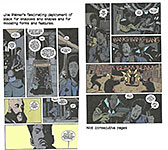
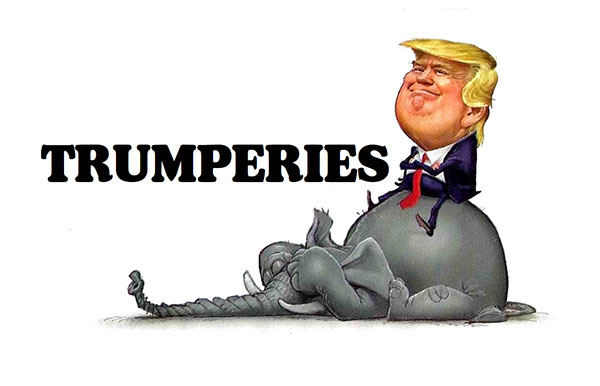
1.jpg)
1.jpg)
2.jpg)
3.jpg)
4.jpg)
5.jpg)
6.jpg)
7.jpg)
8.jpg)
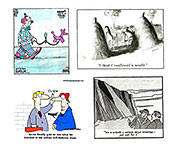
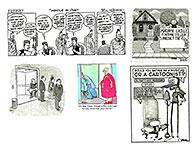
9.jpg)
10.jpg)
11.jpg)
12.jpg)
13.jpg)
14.jpg)
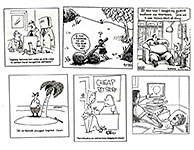
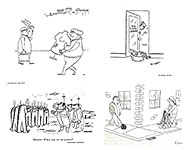
15.jpg)
16.jpg)
17.jpg)
18.jpg)
19.jpg)
20.jpg)
21.jpg)
22.jpg)
1.jpg)
2.jpg)
3.jpg)
4.jpg)

